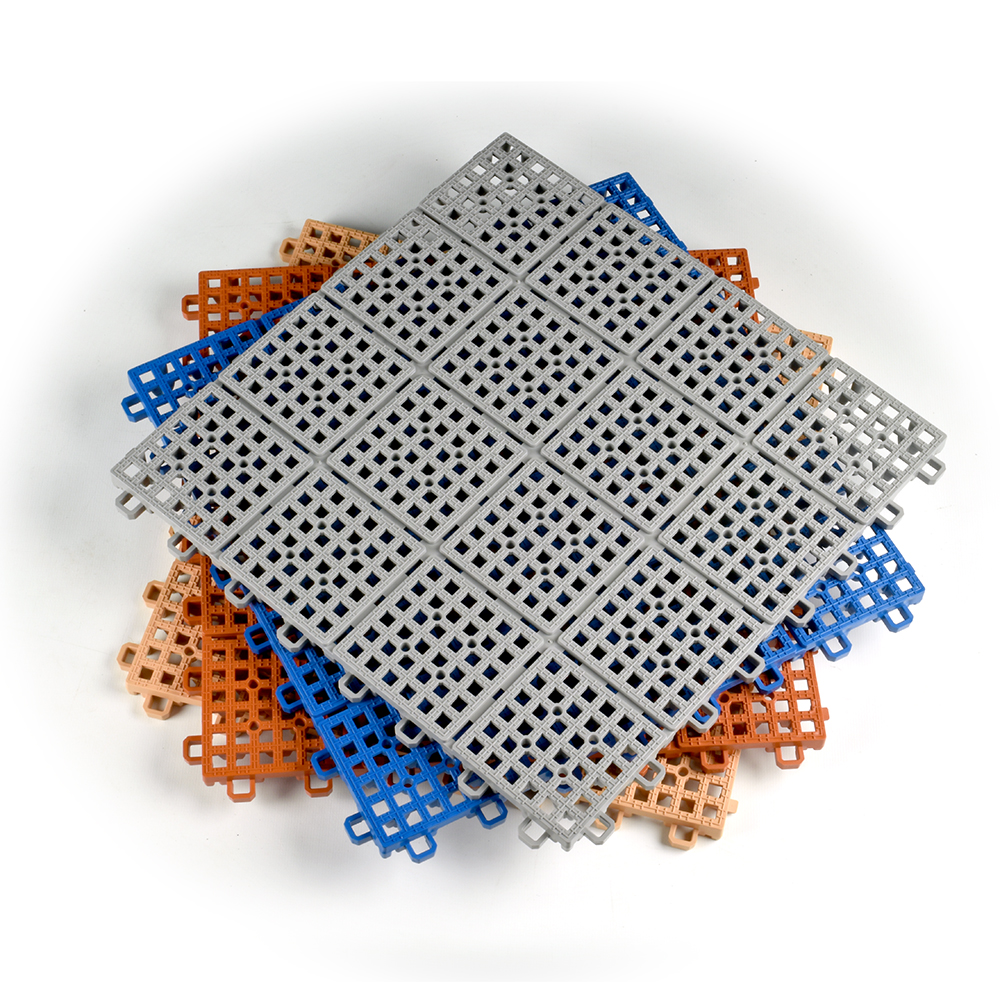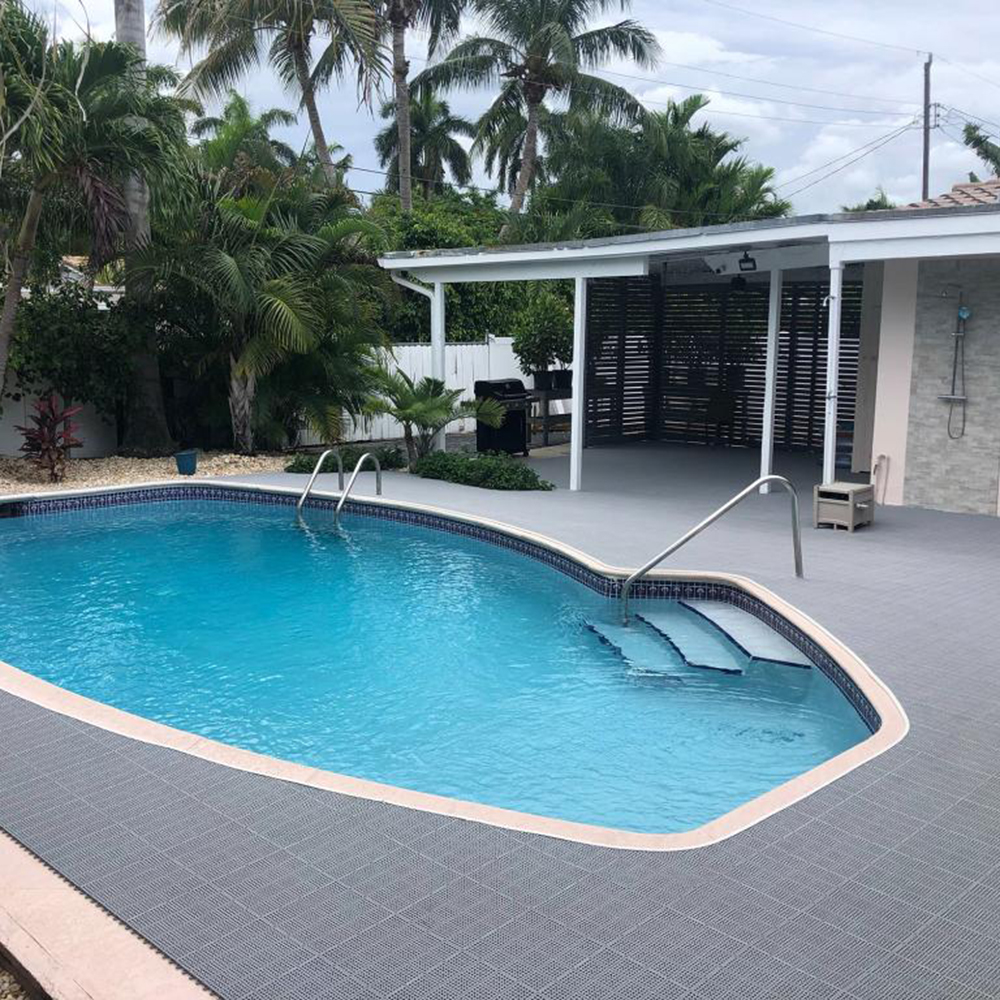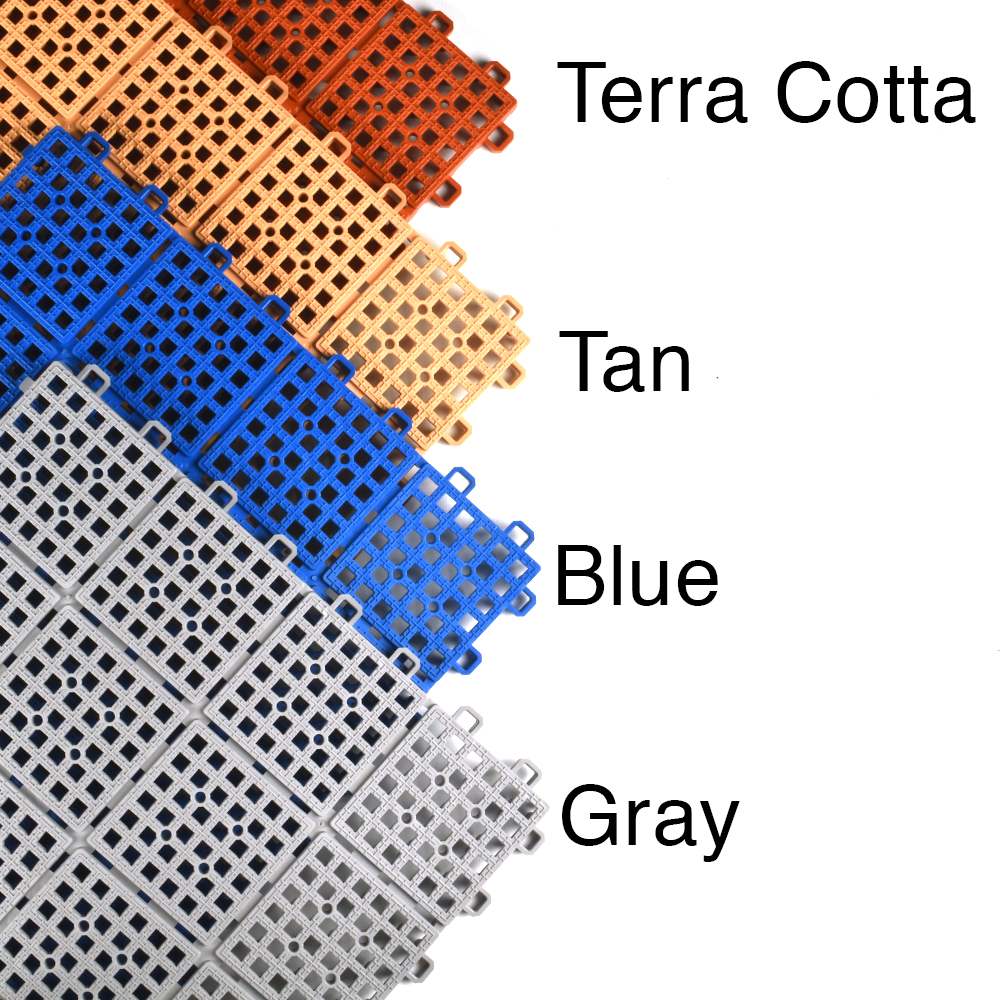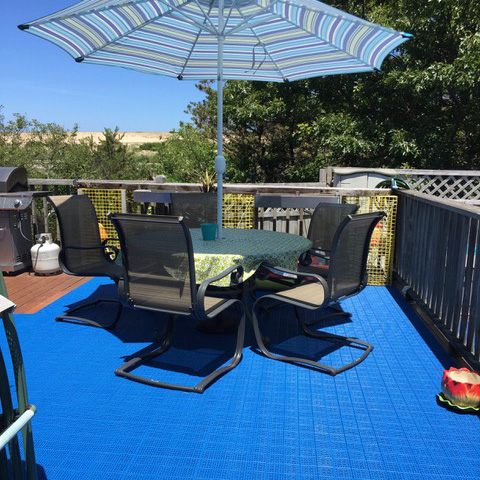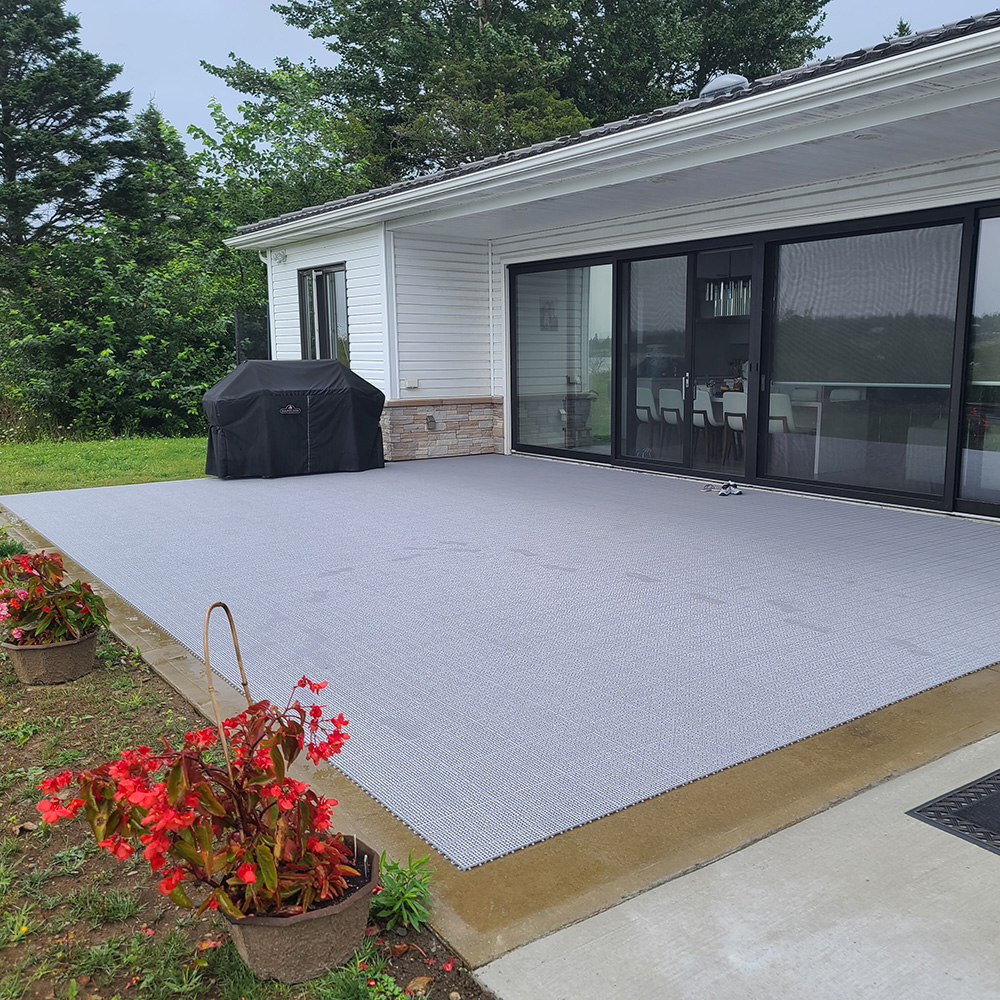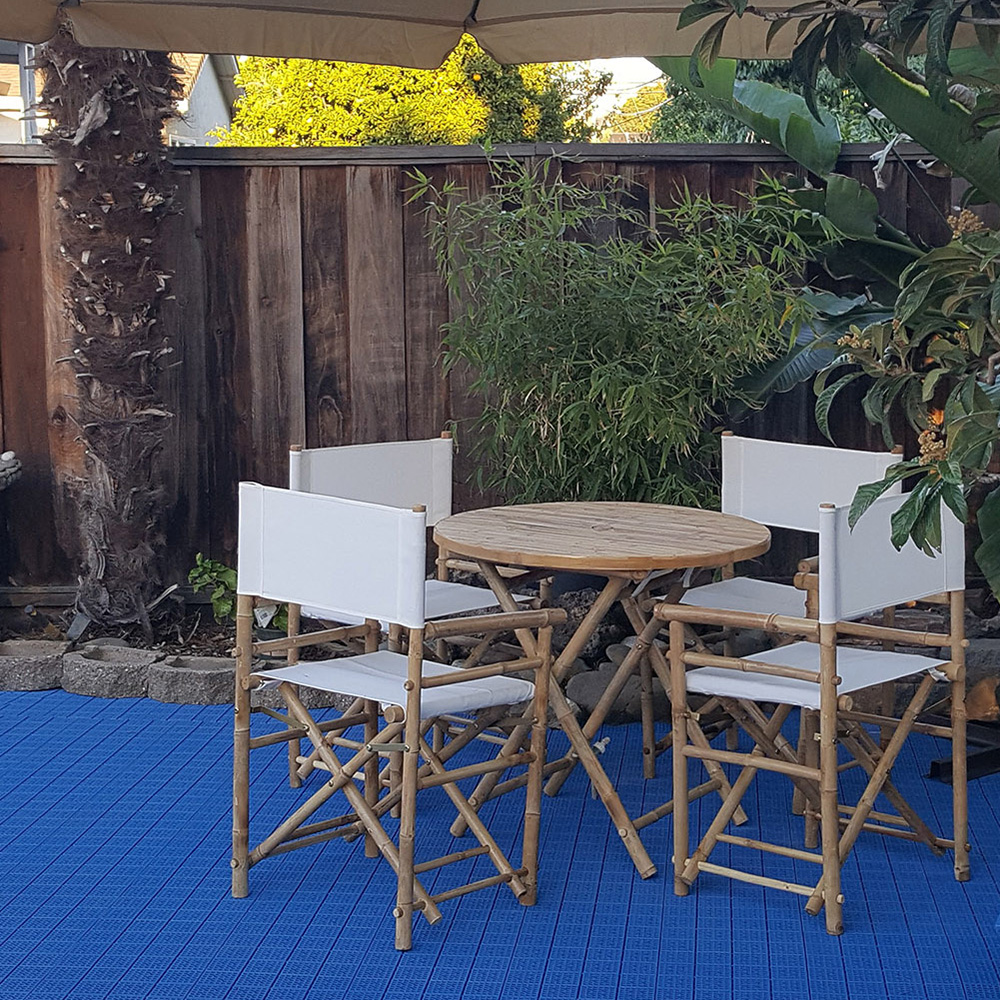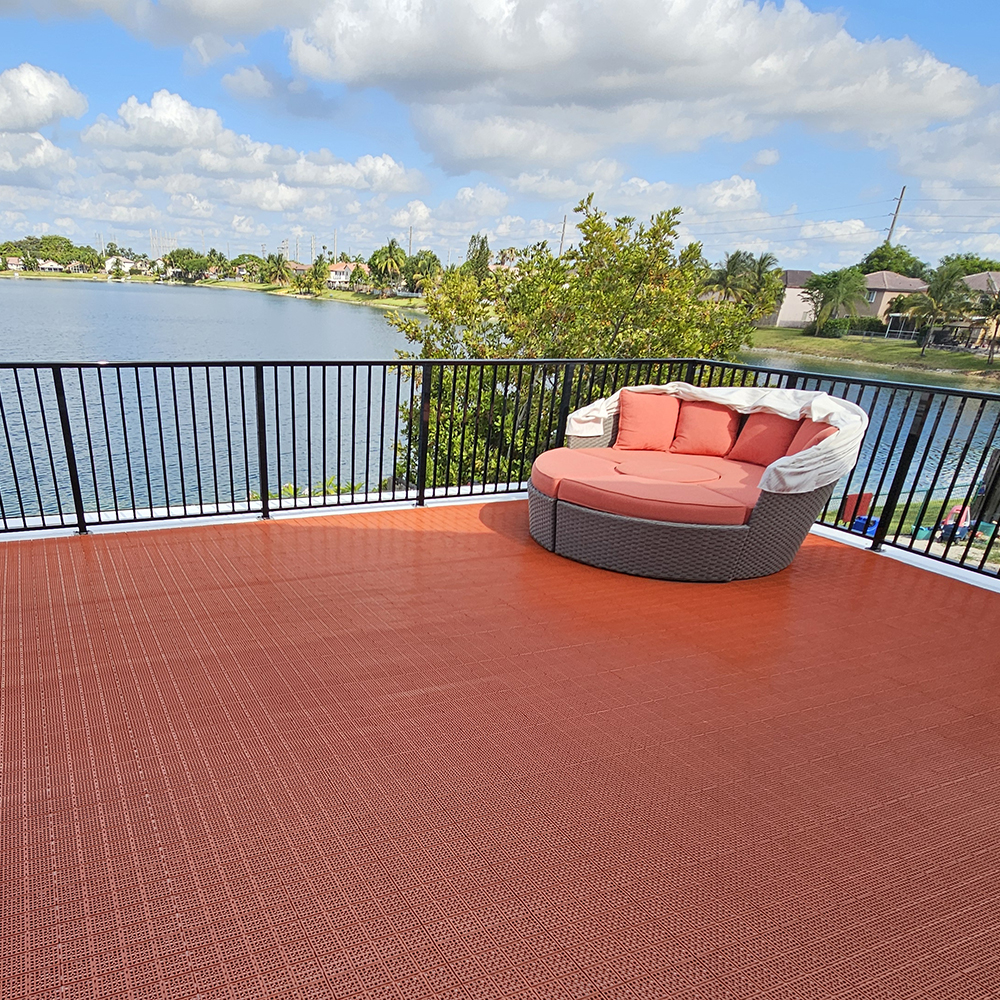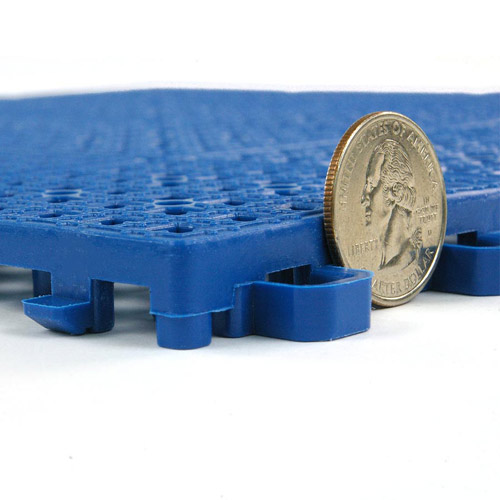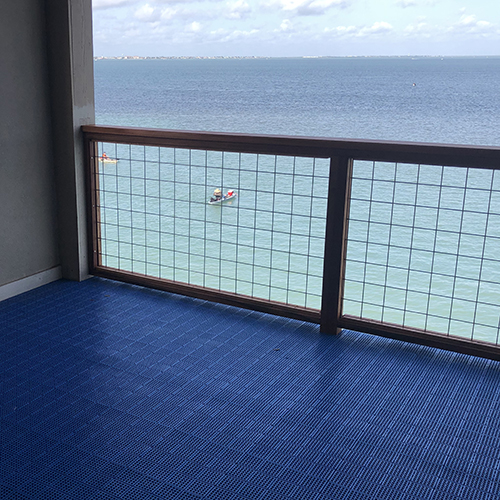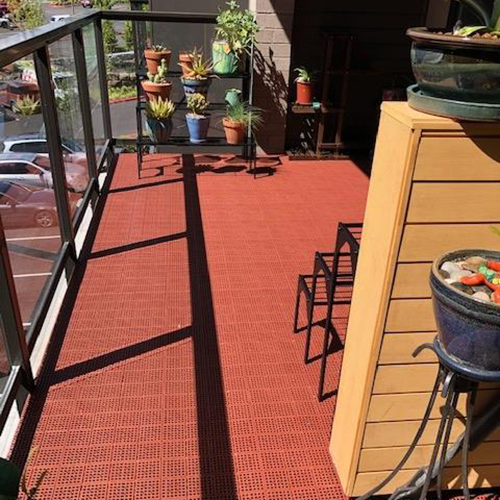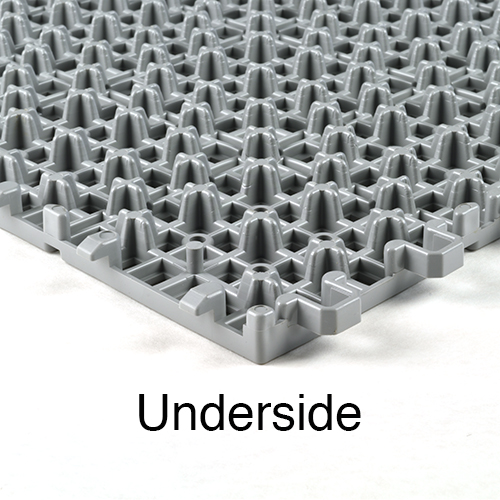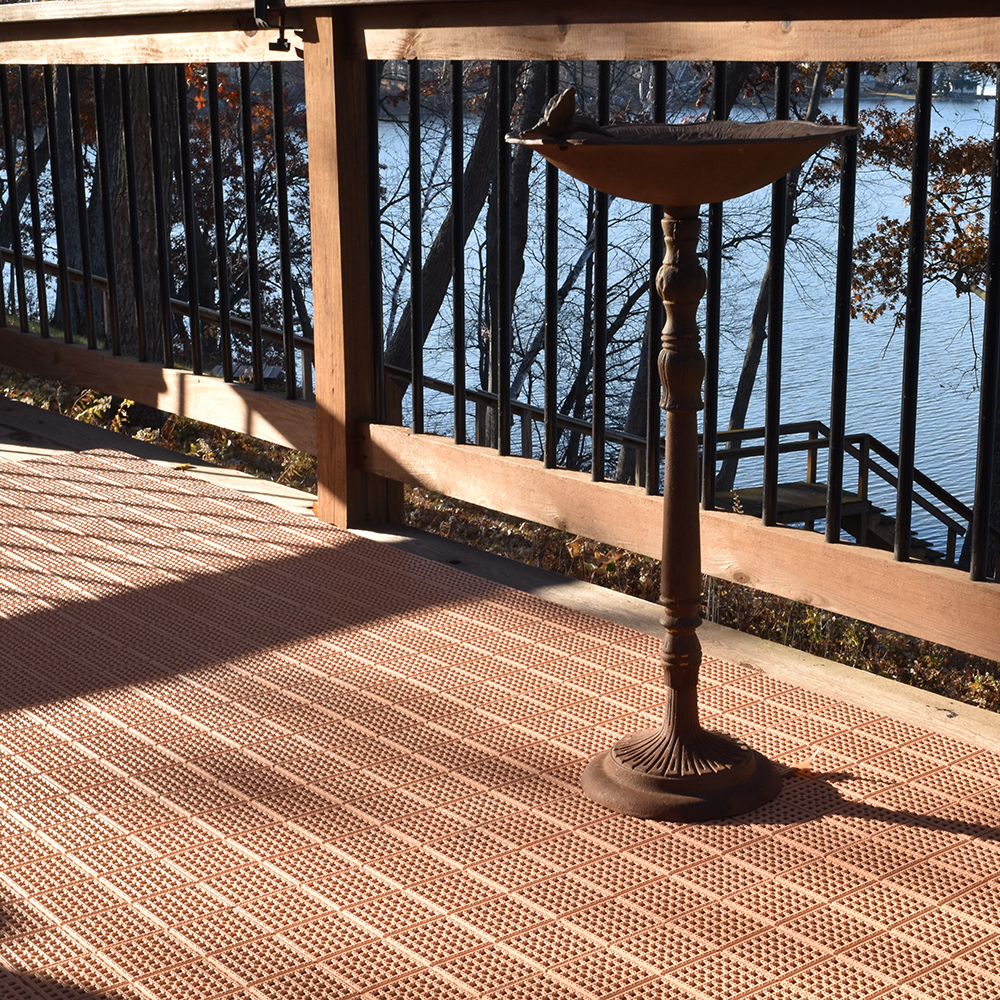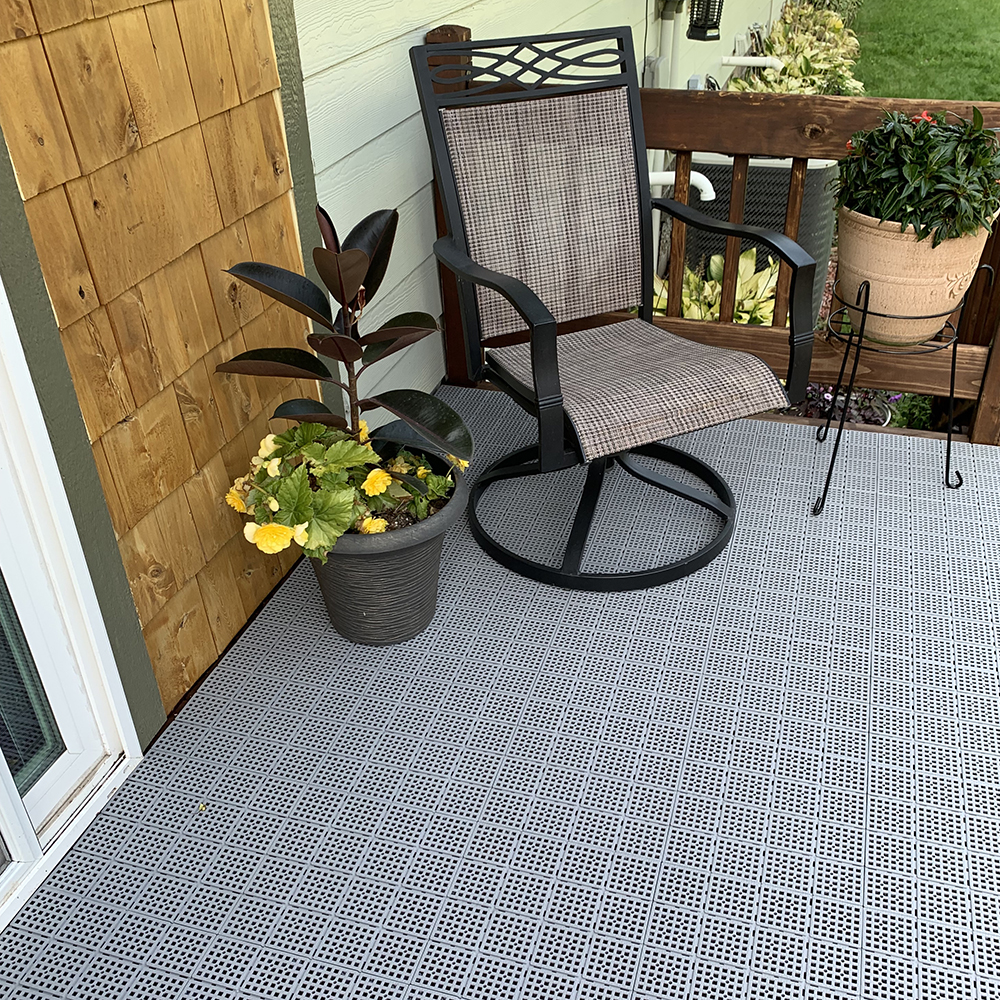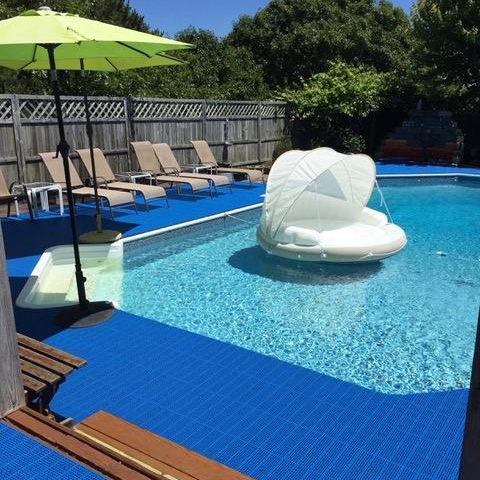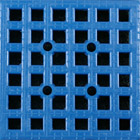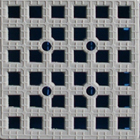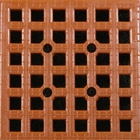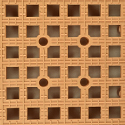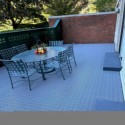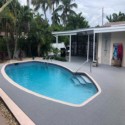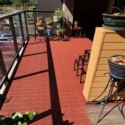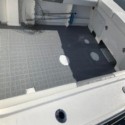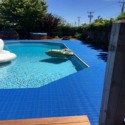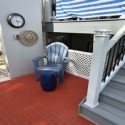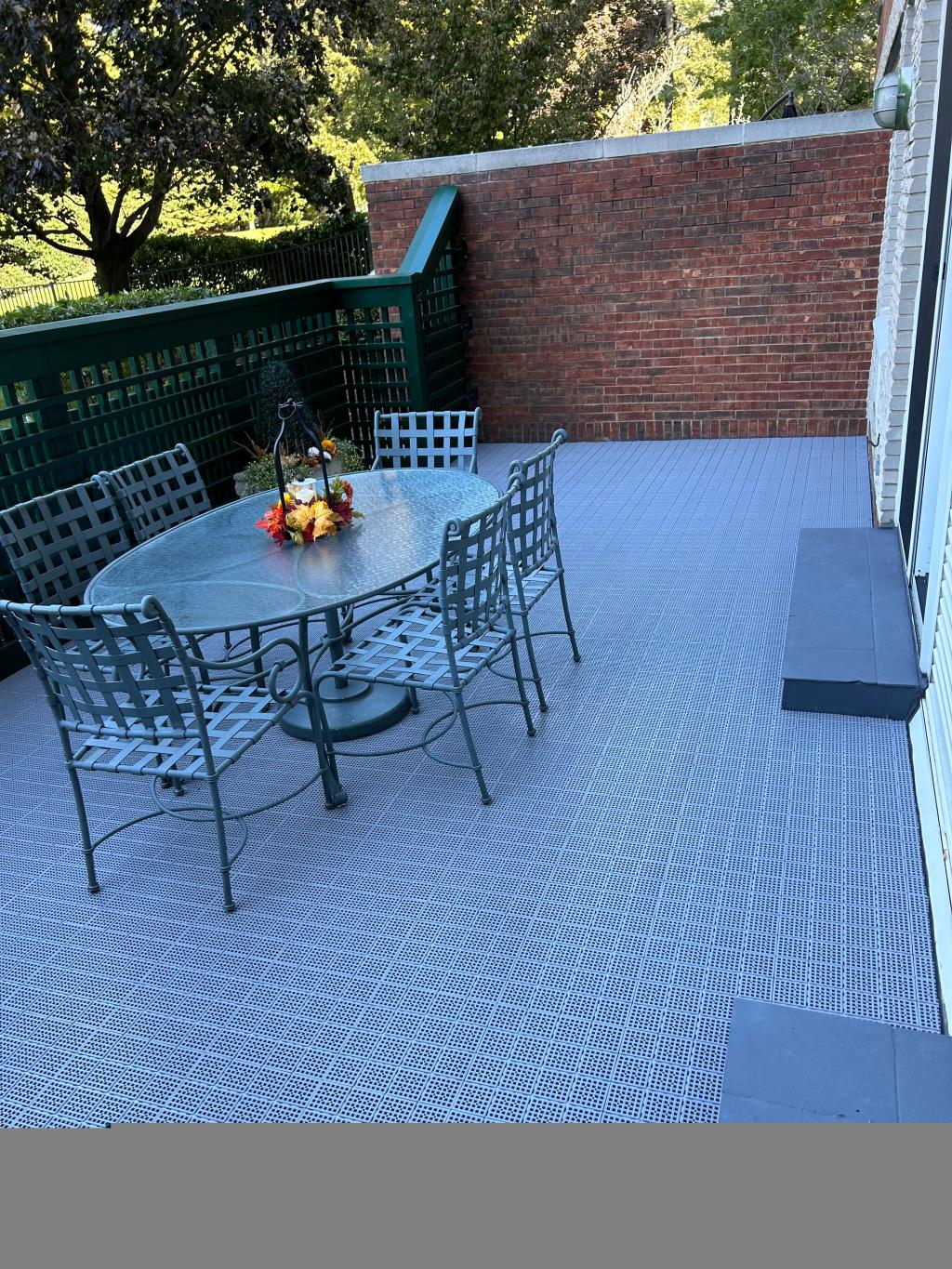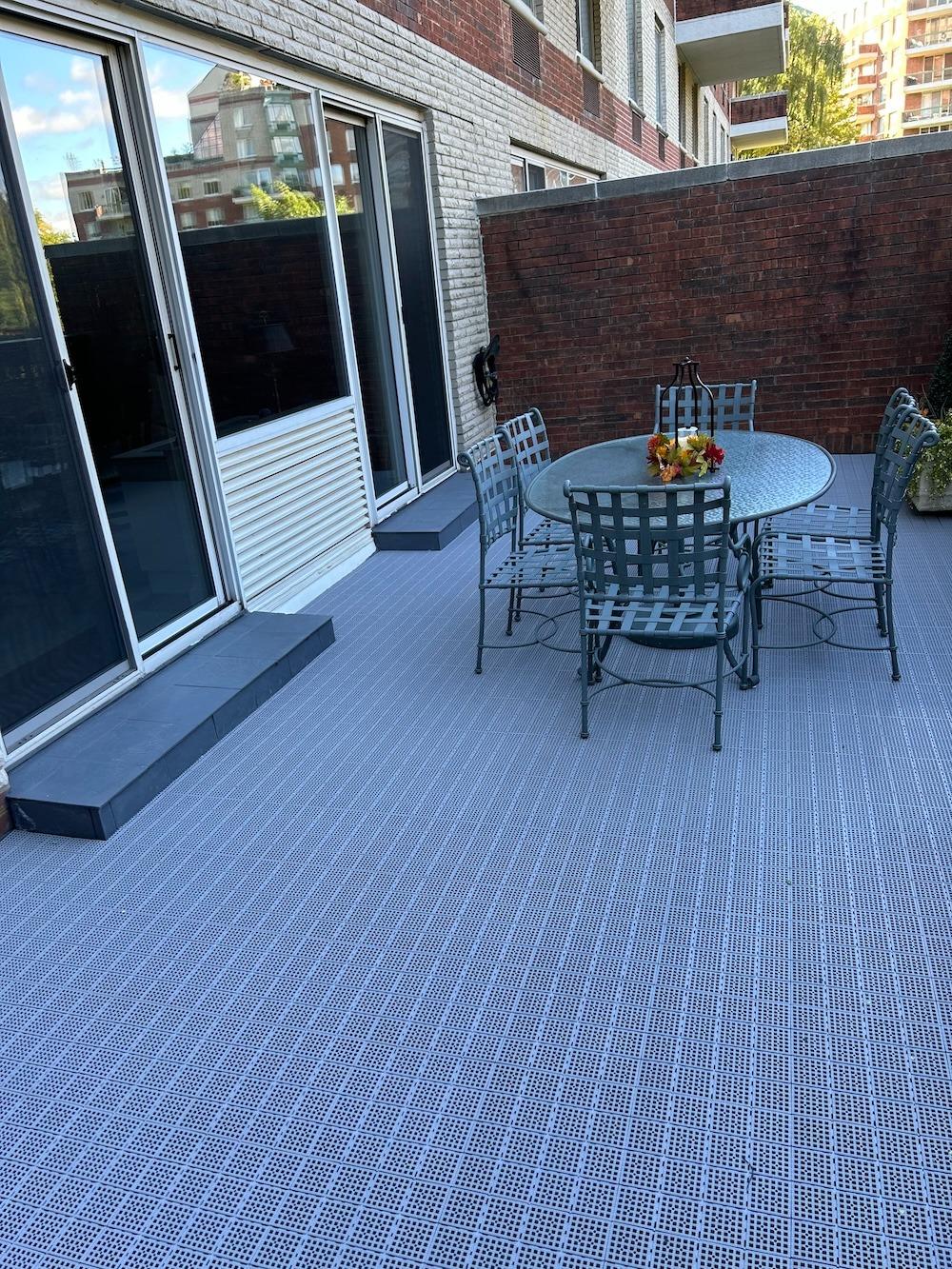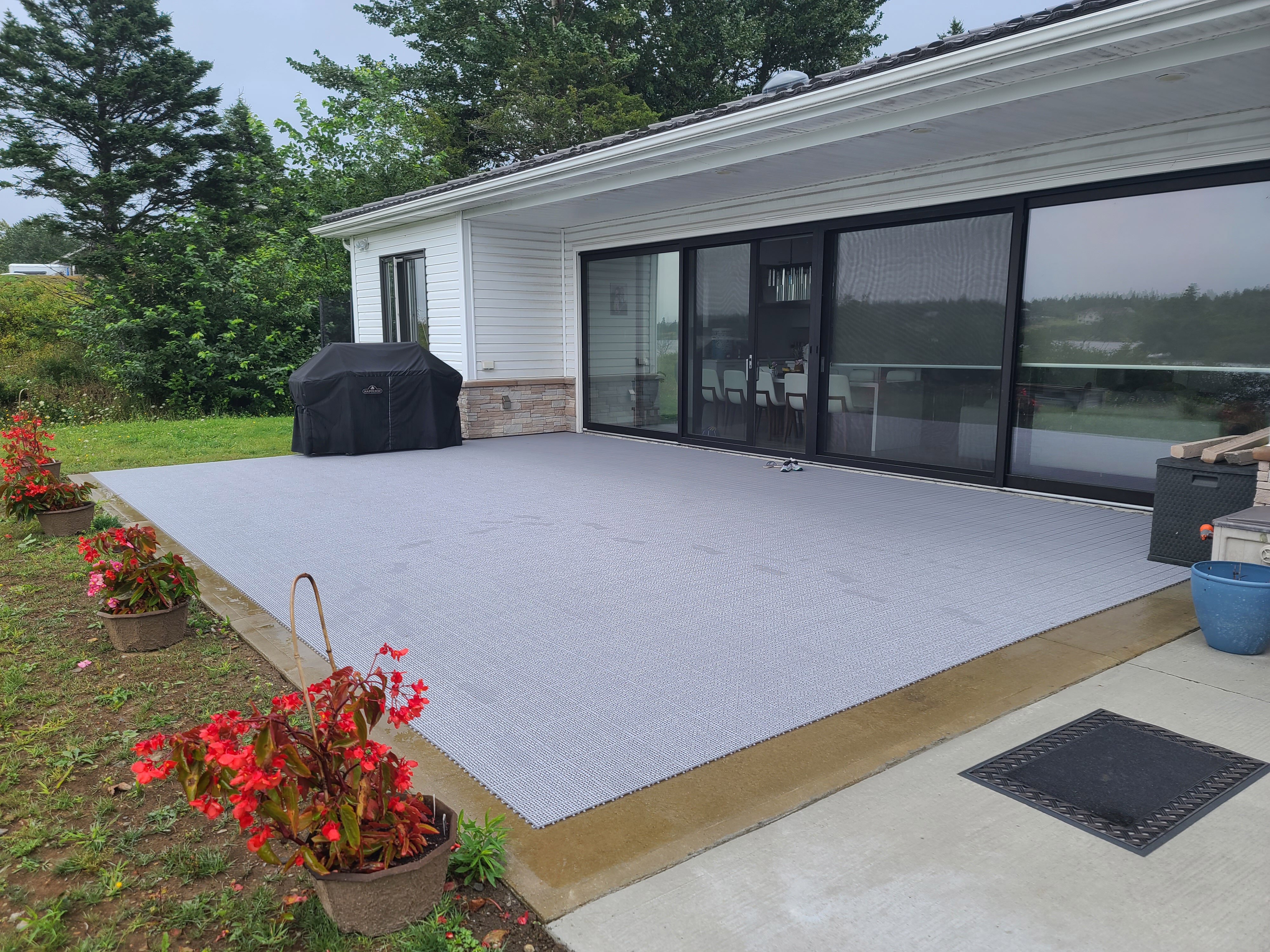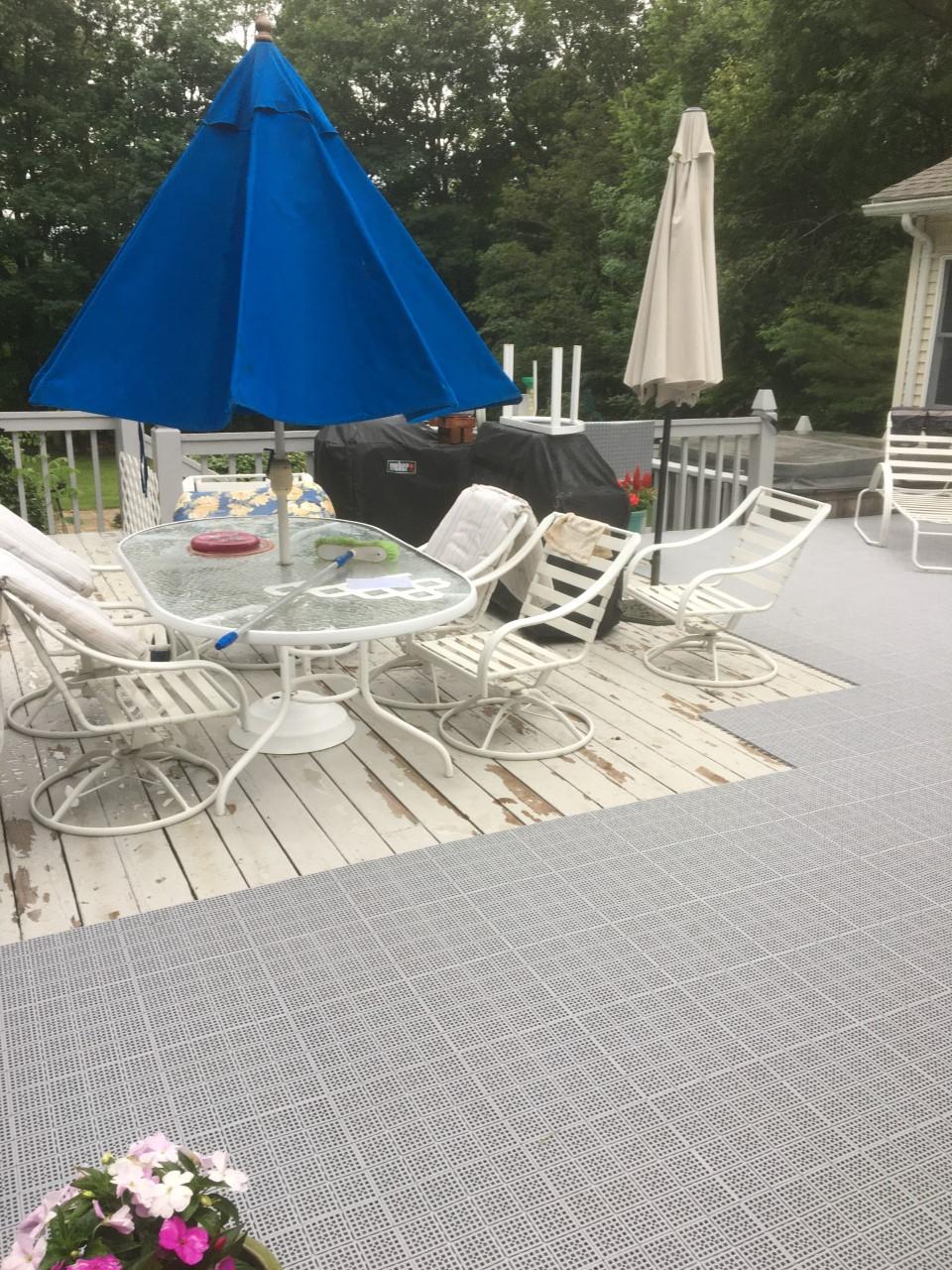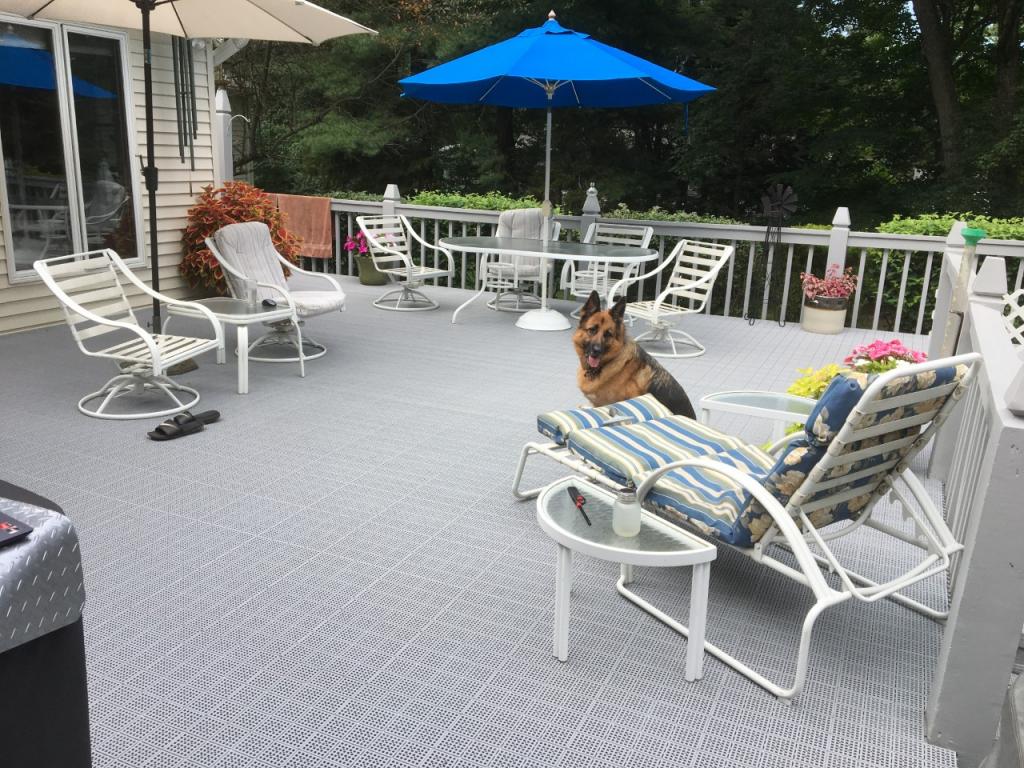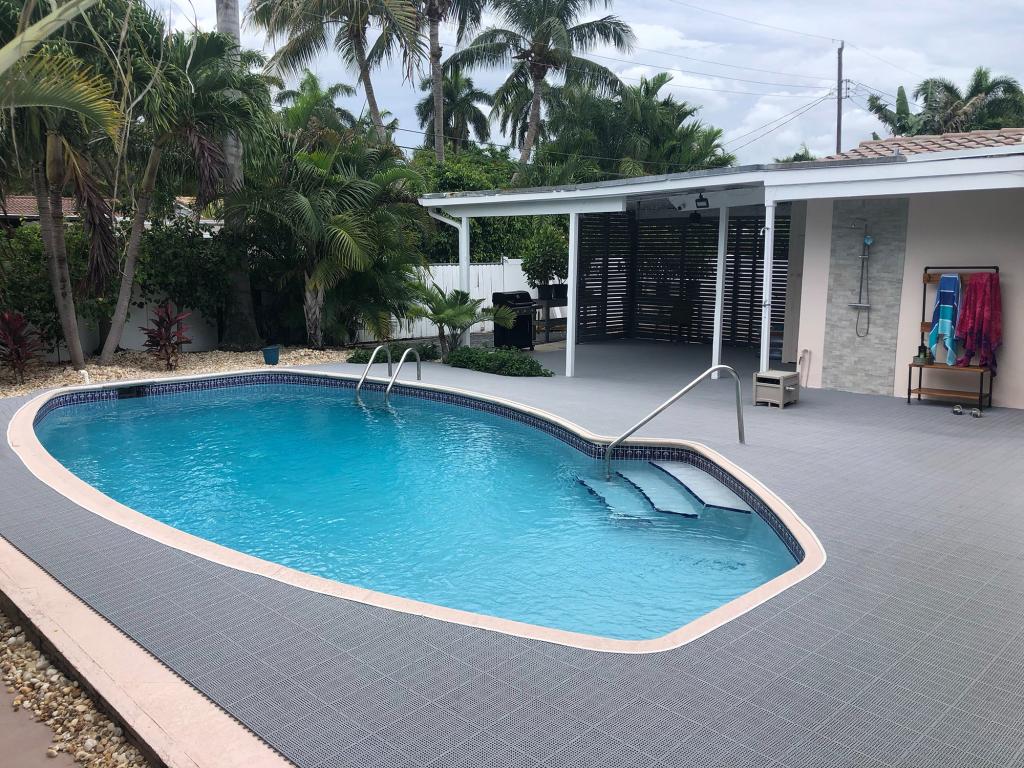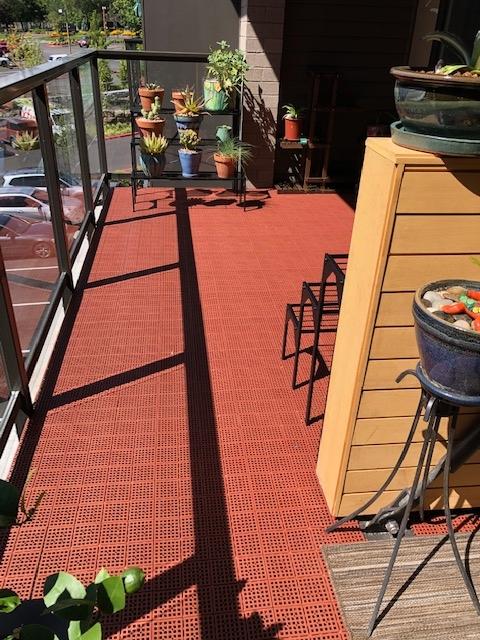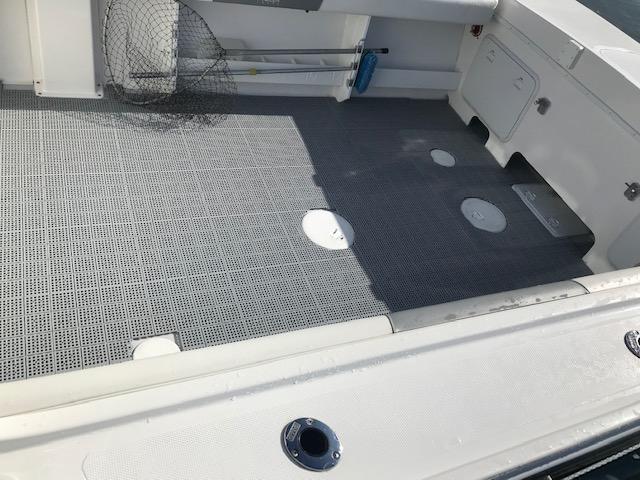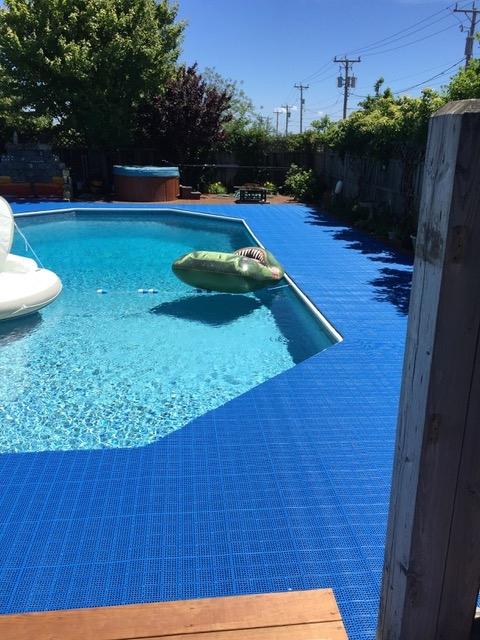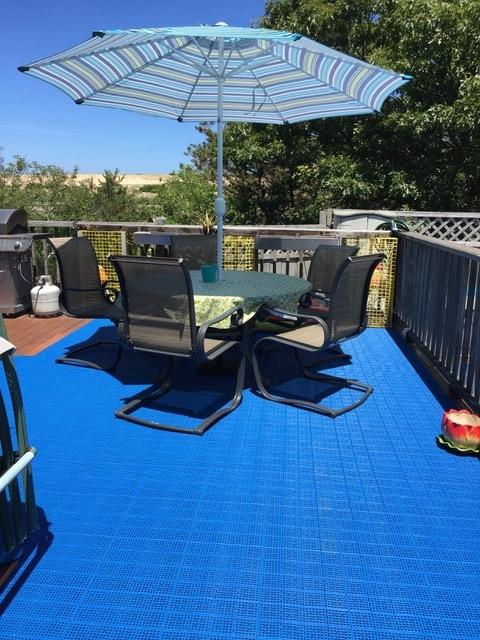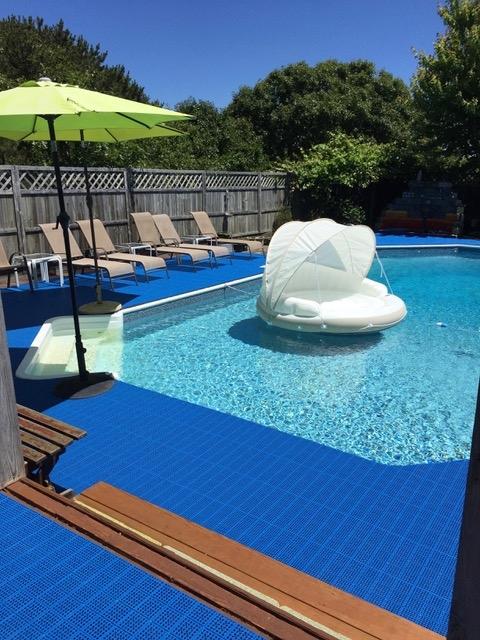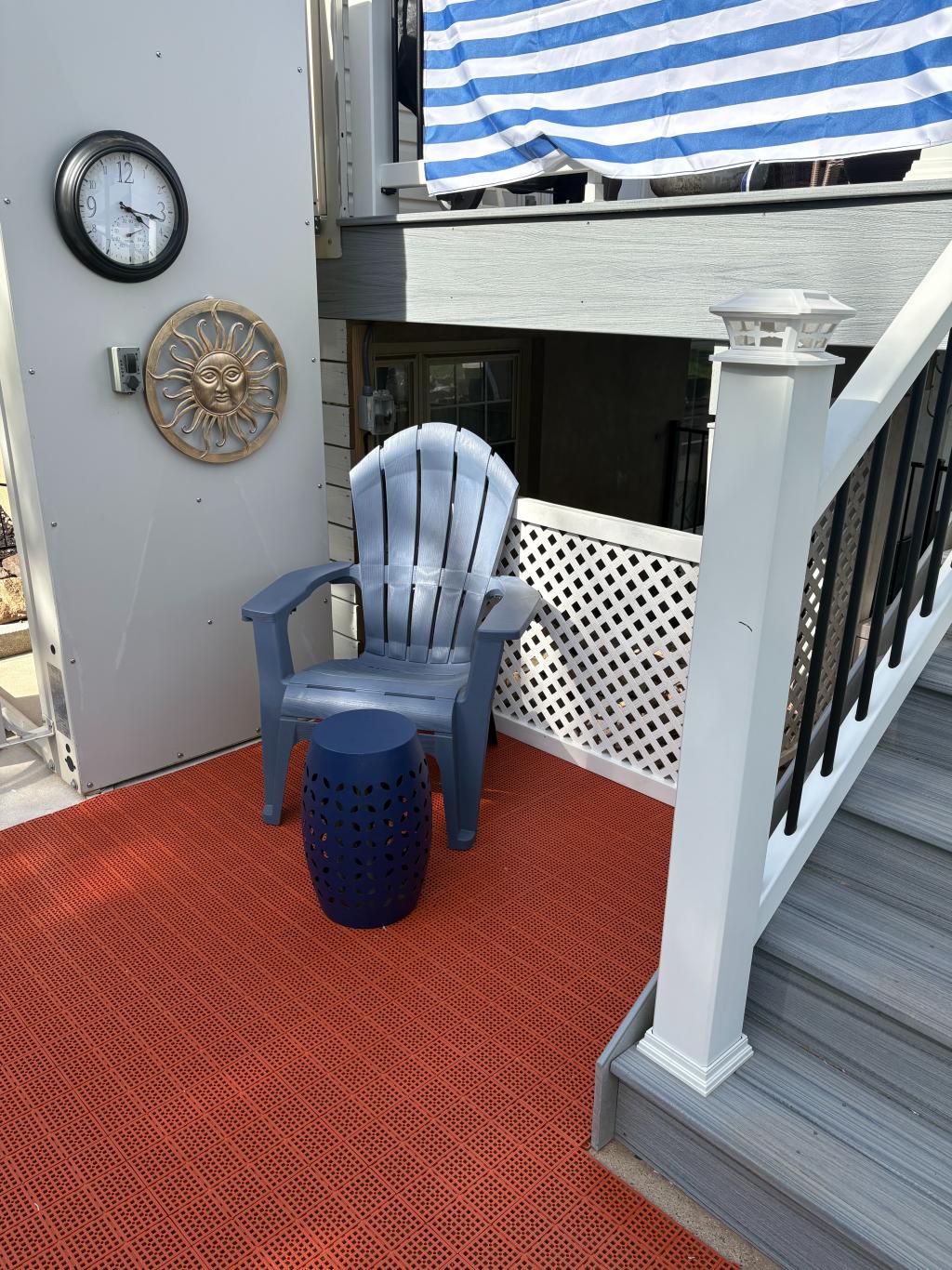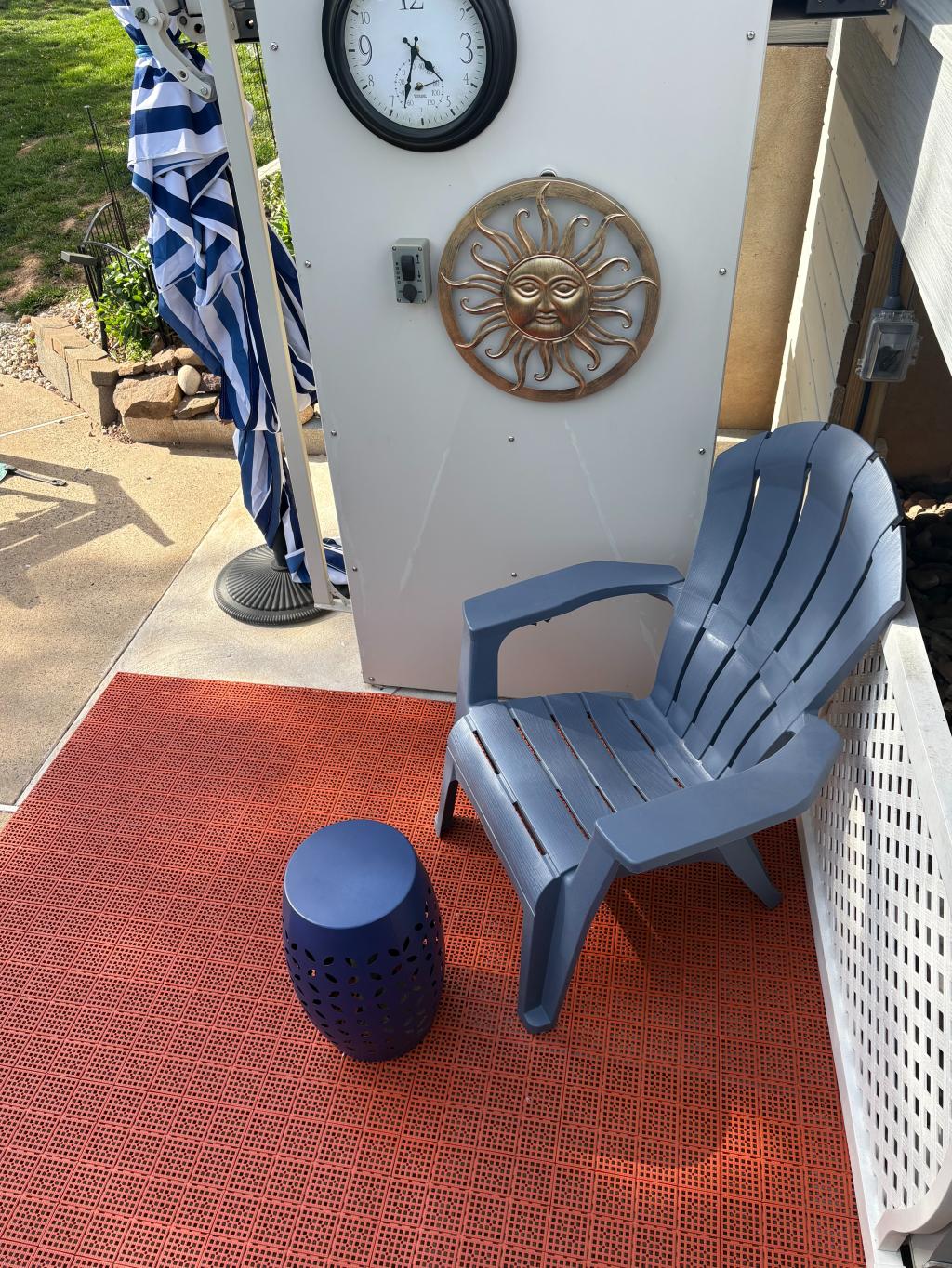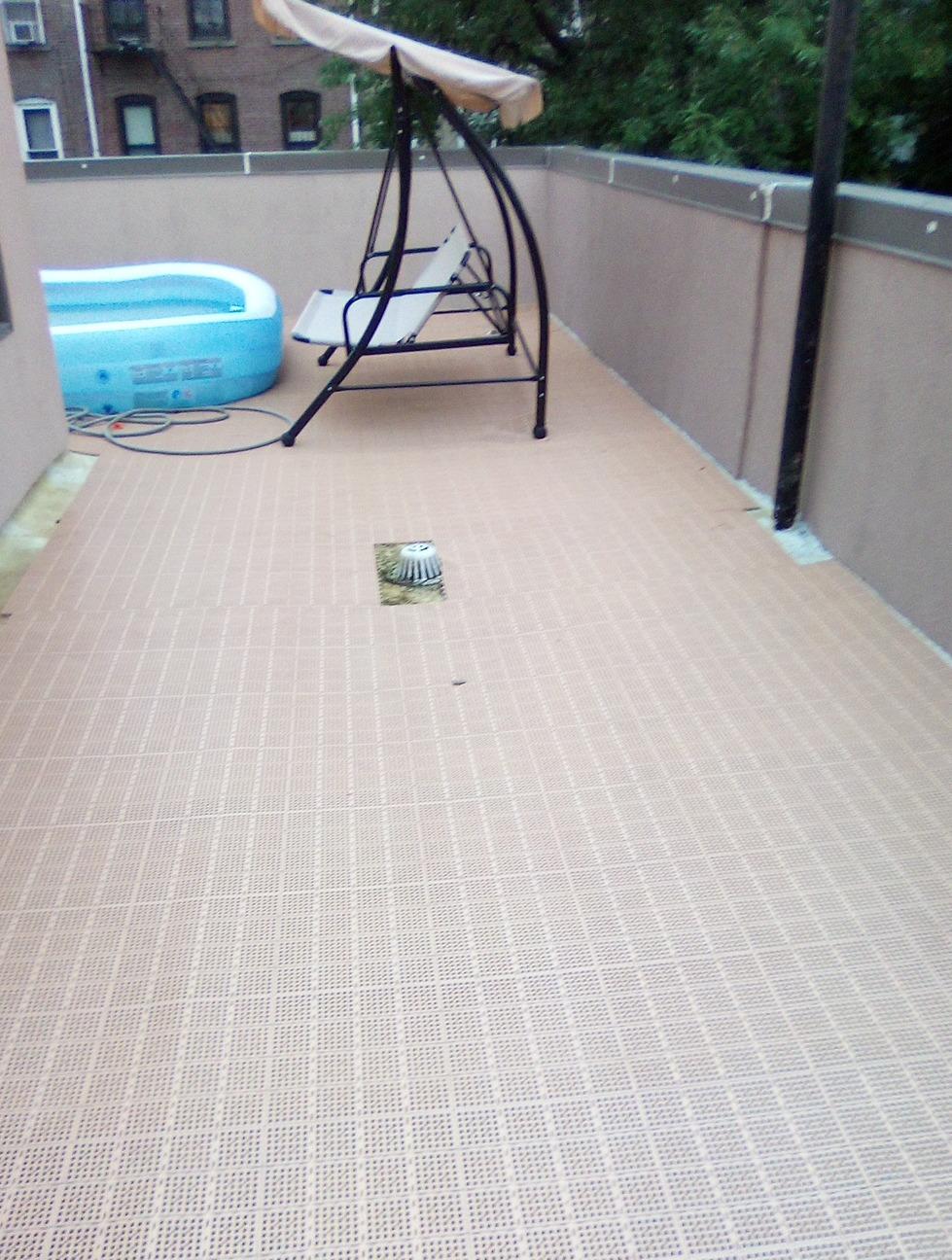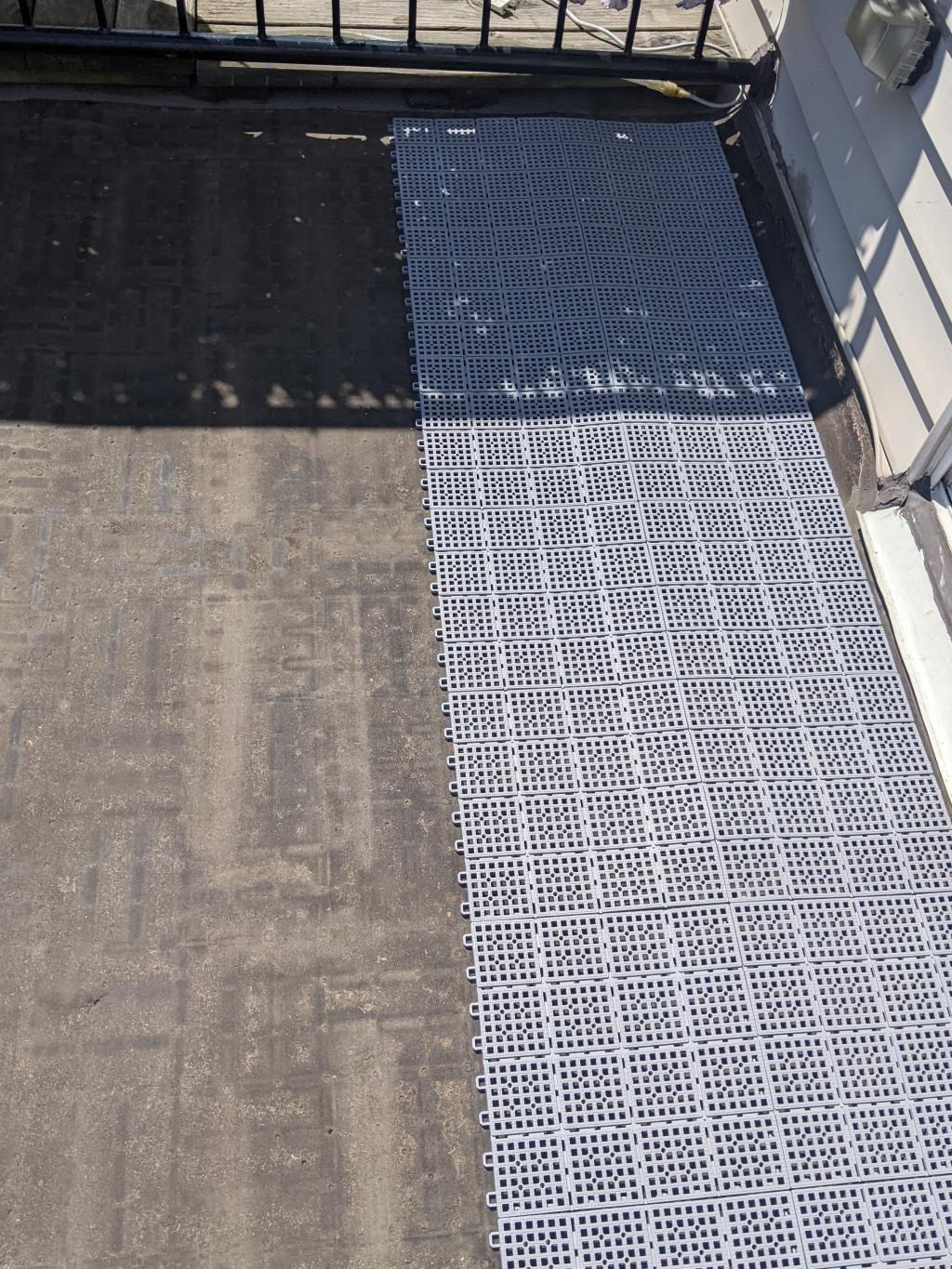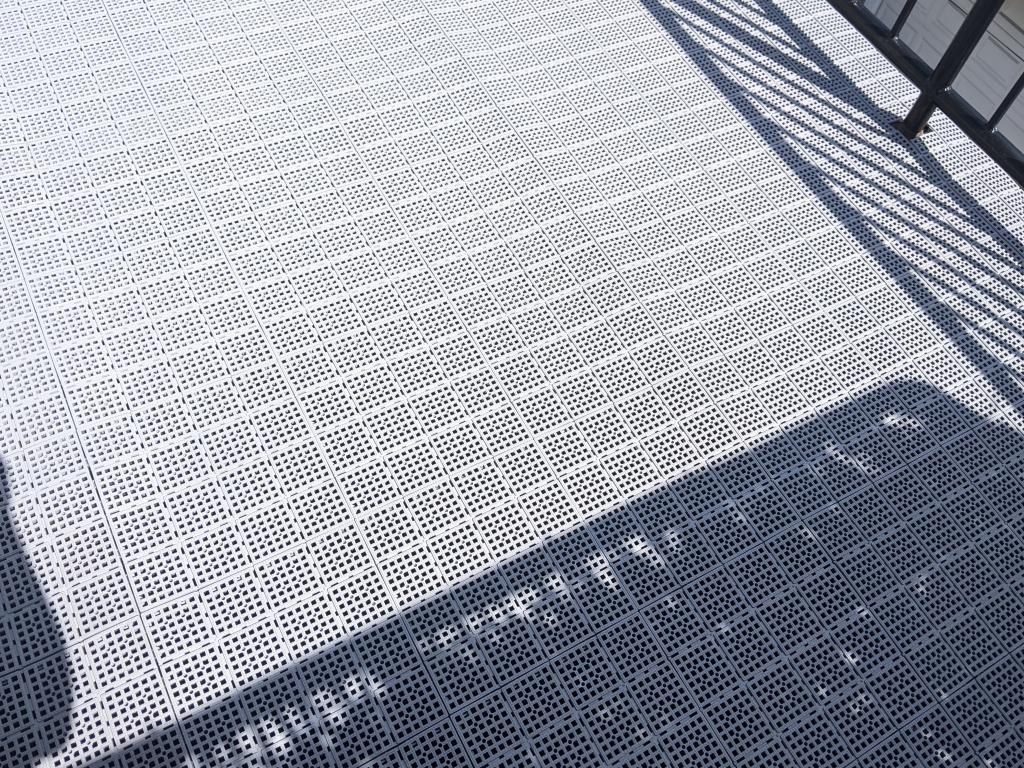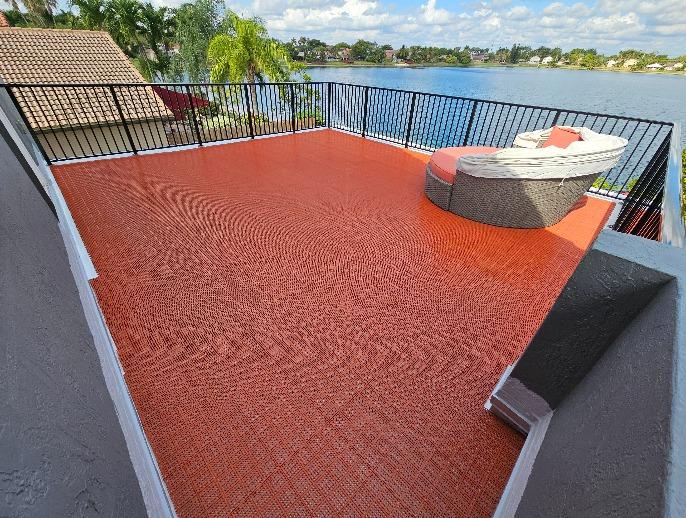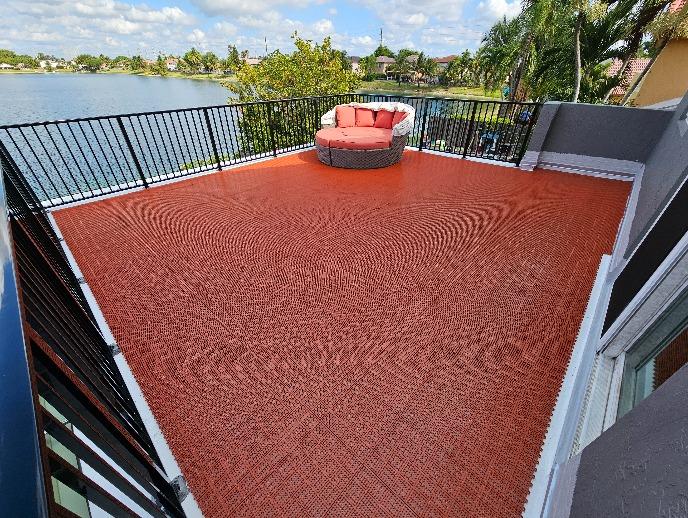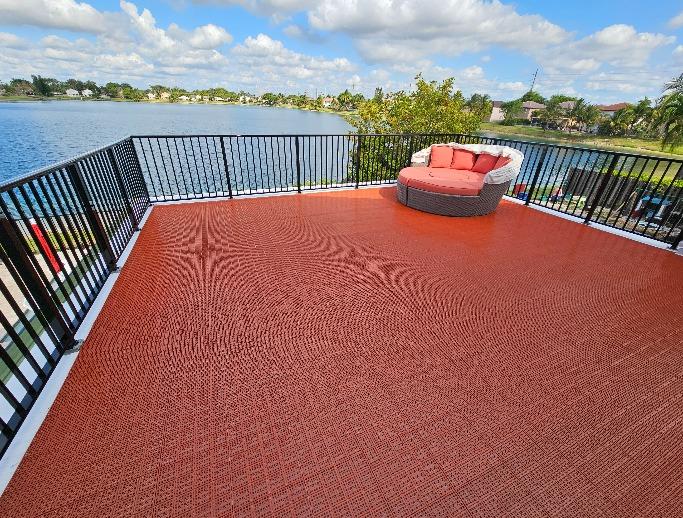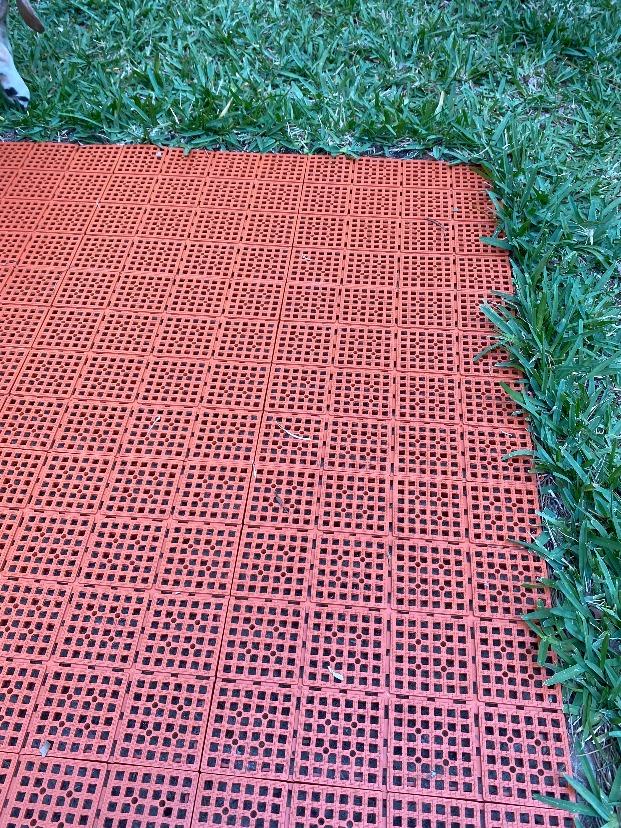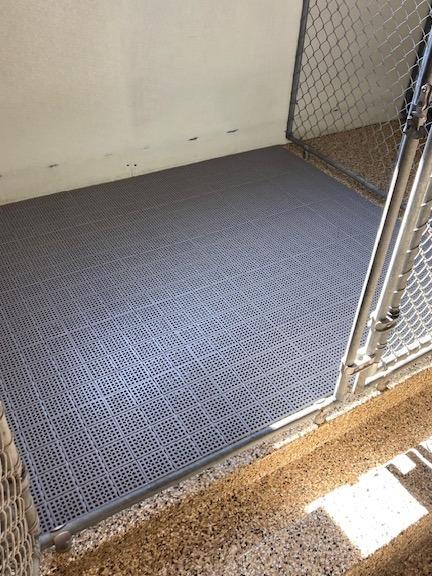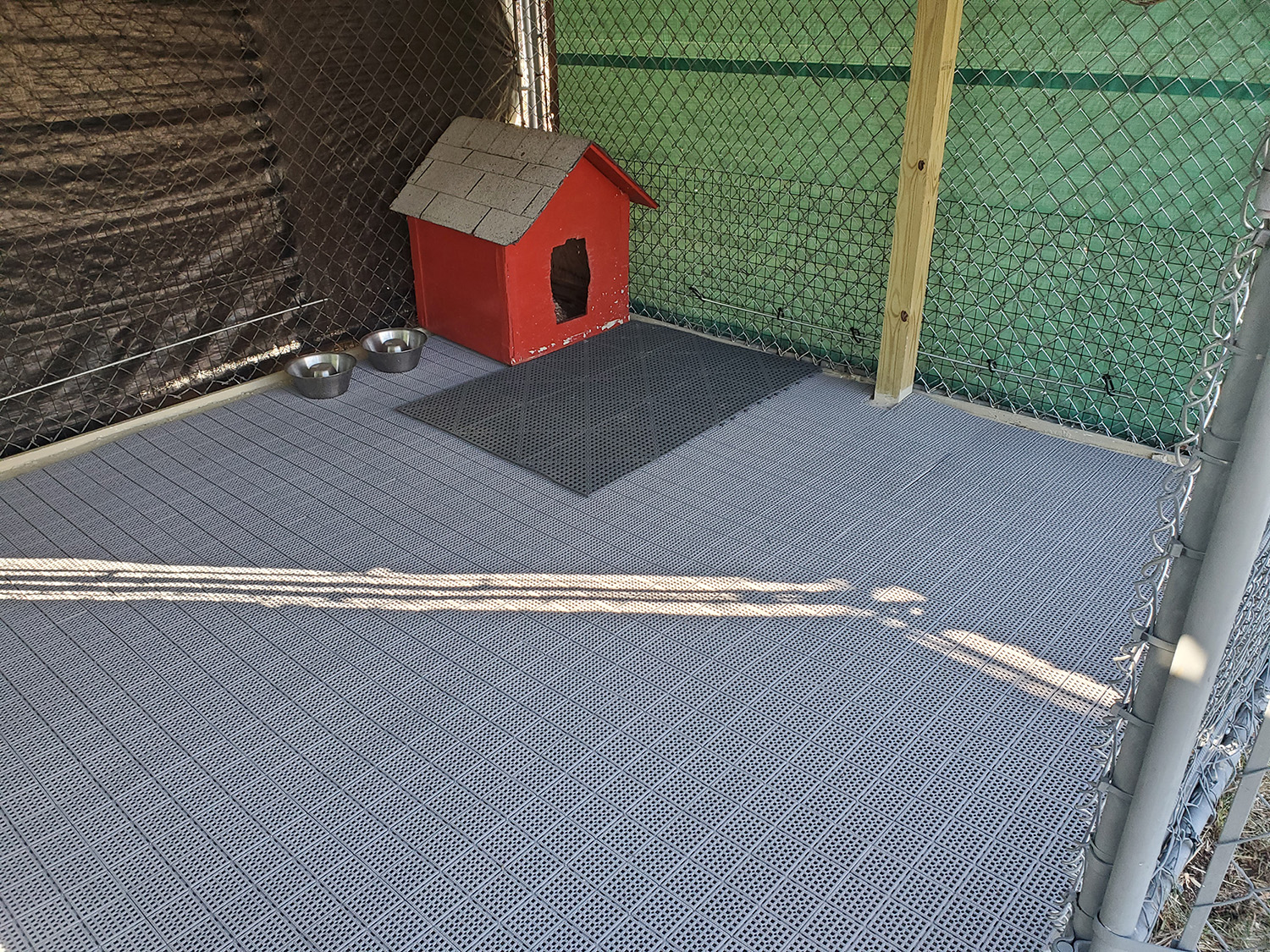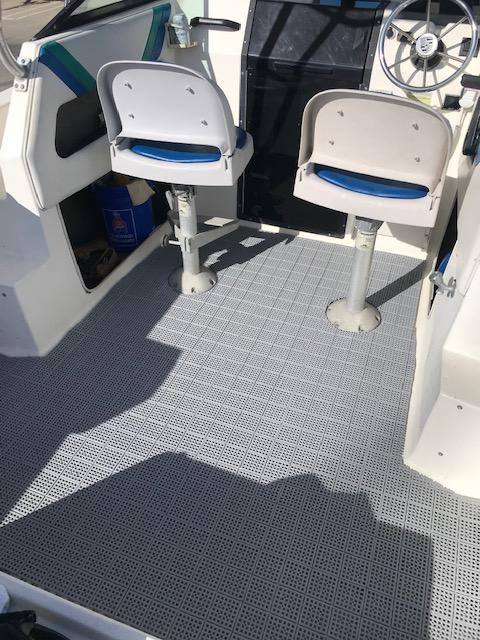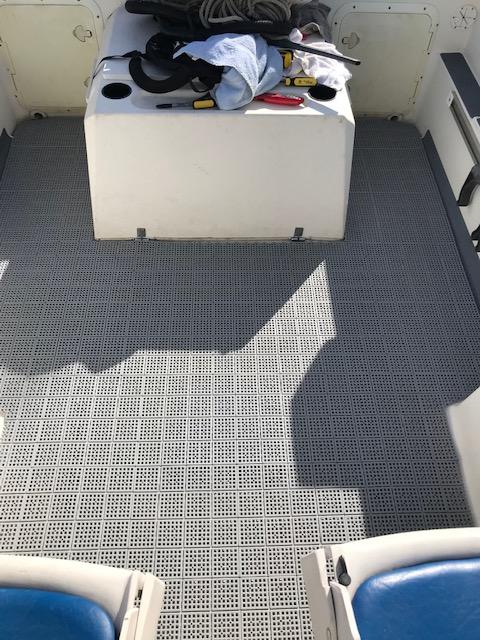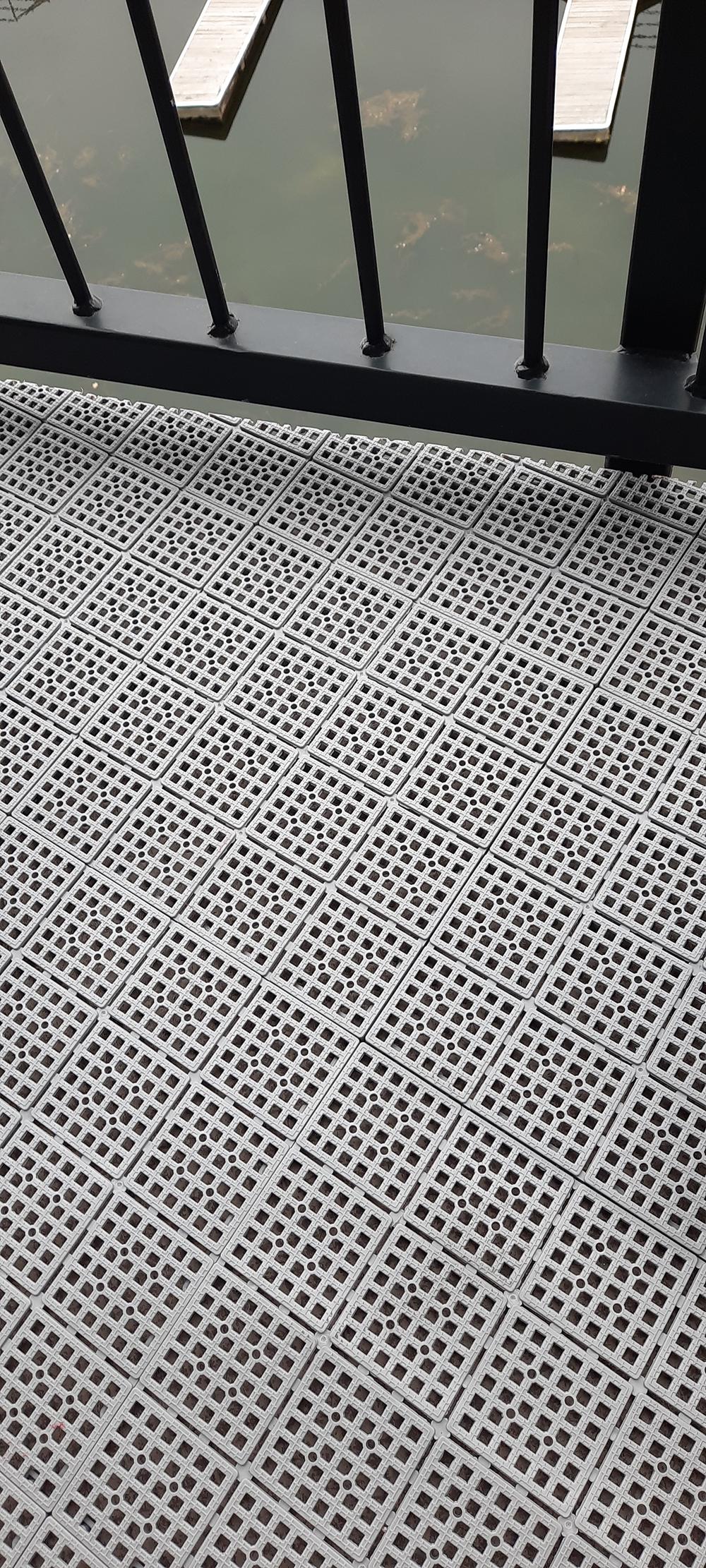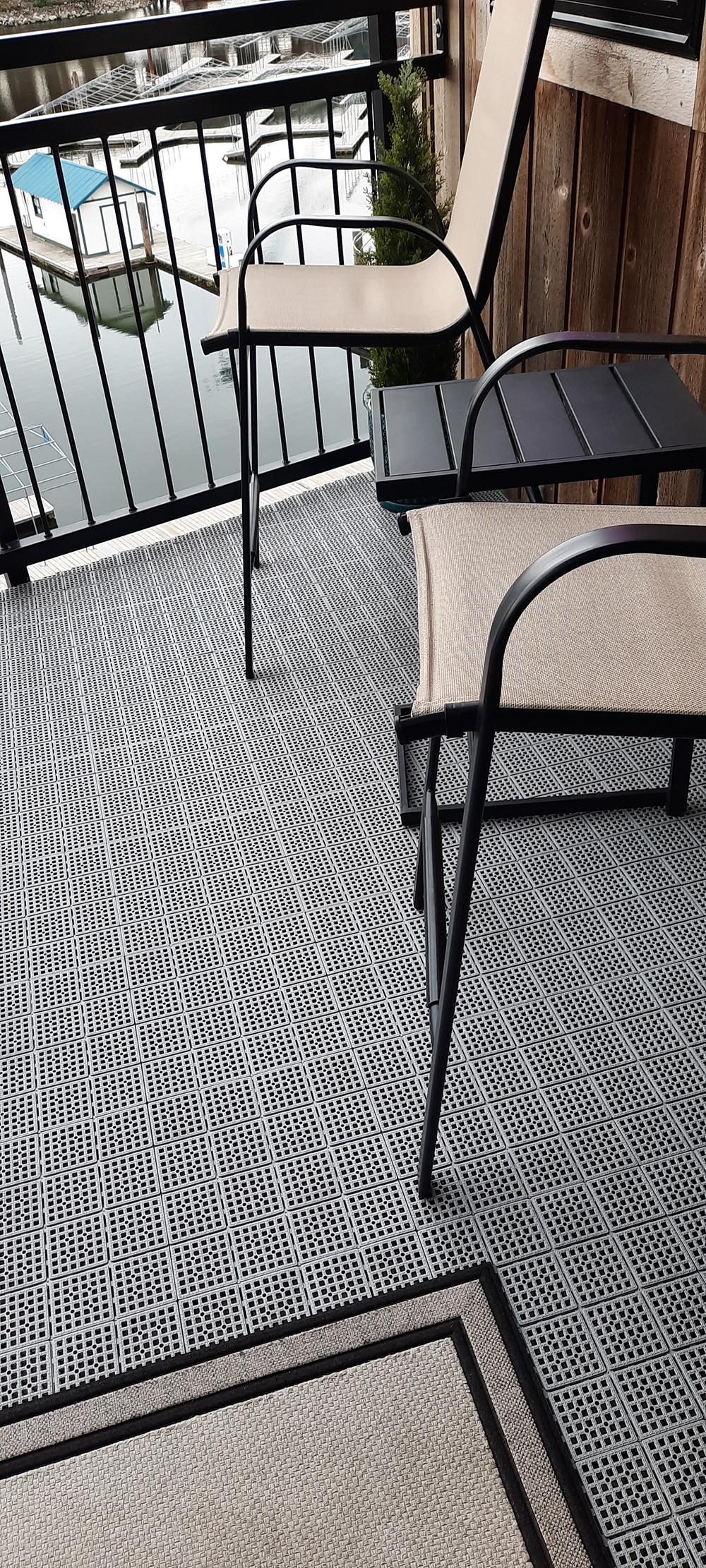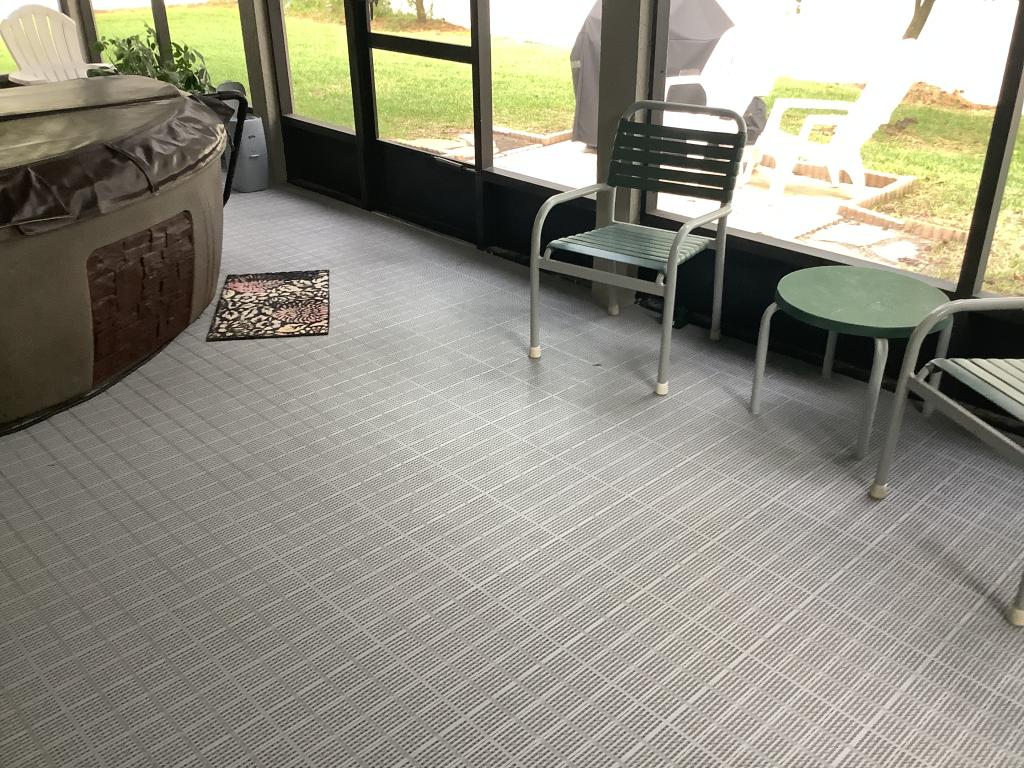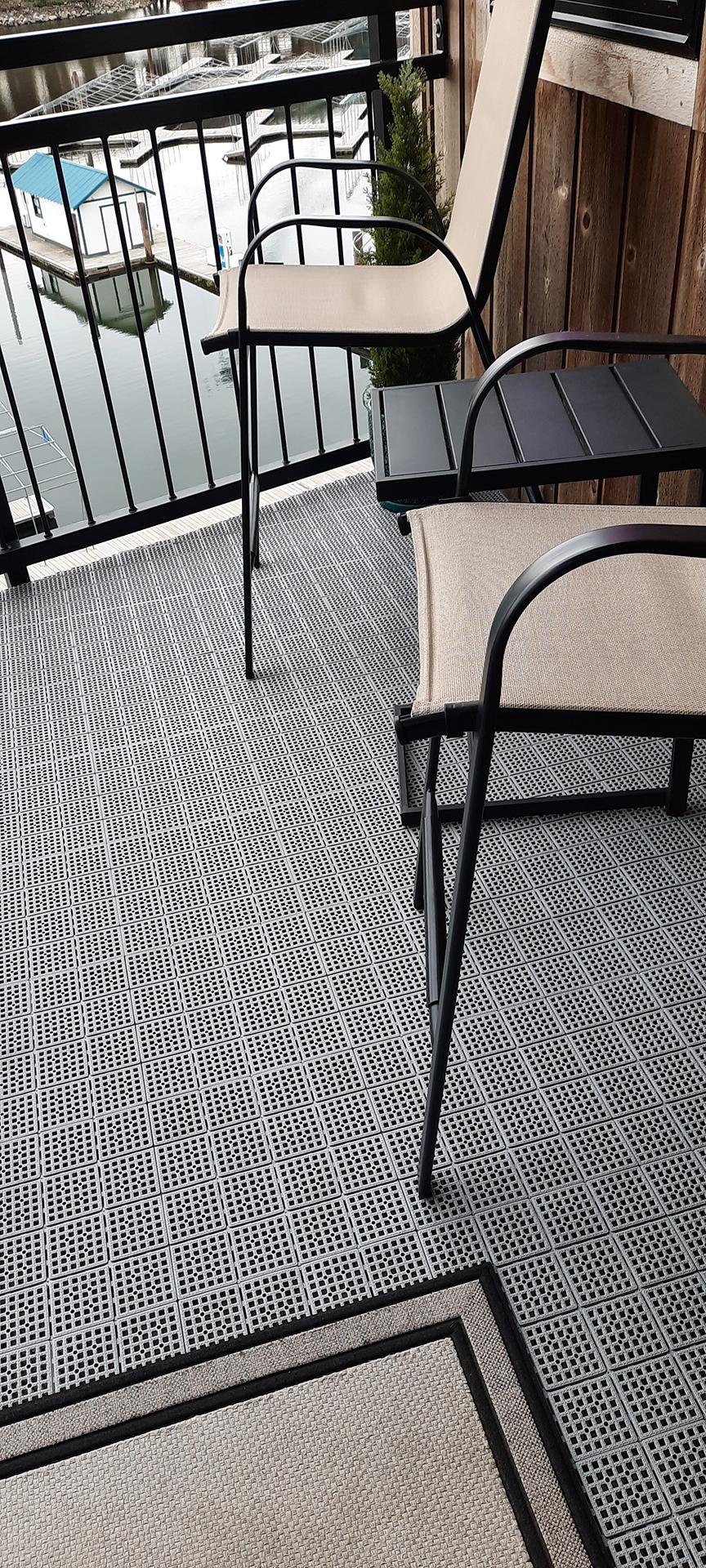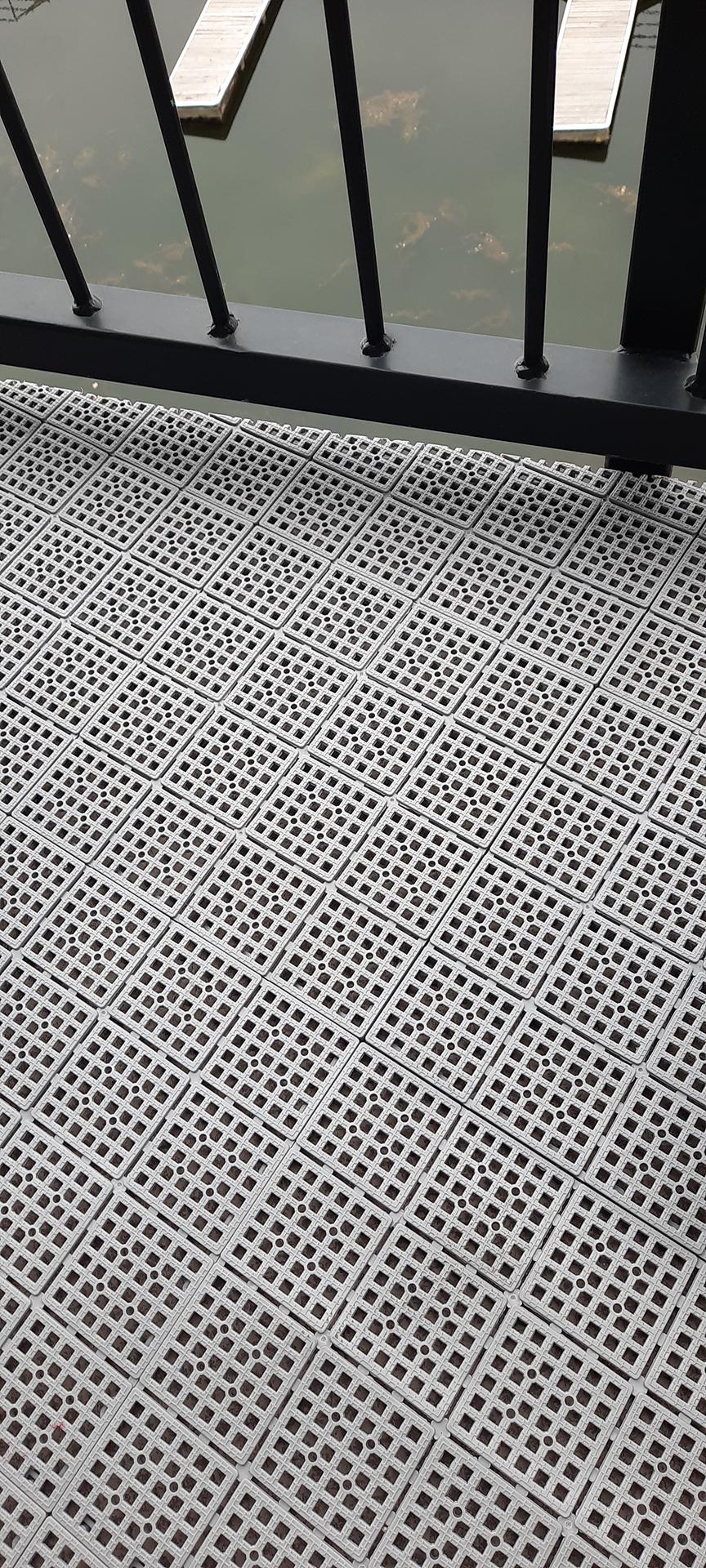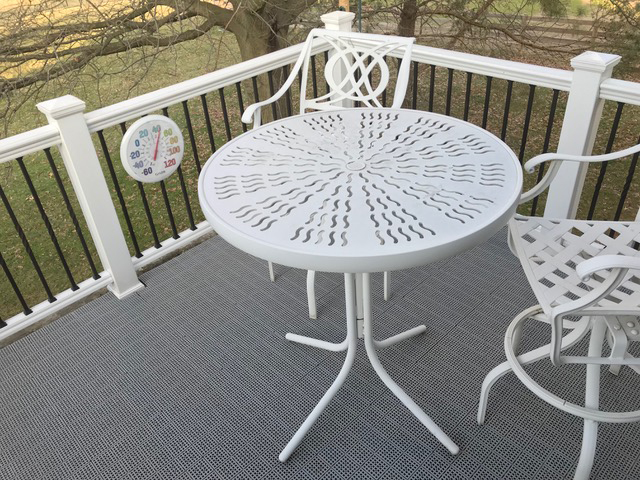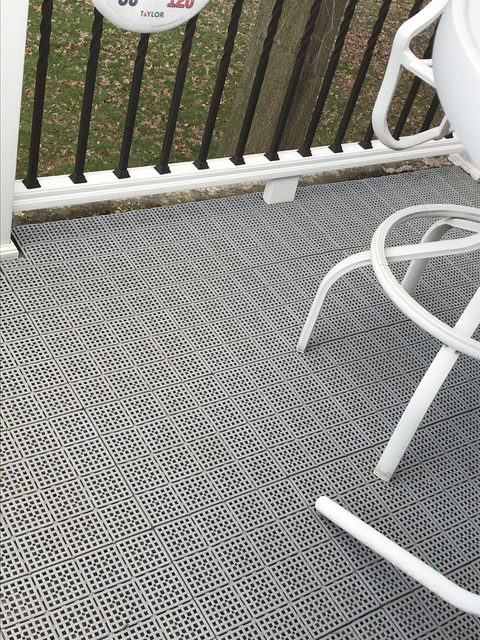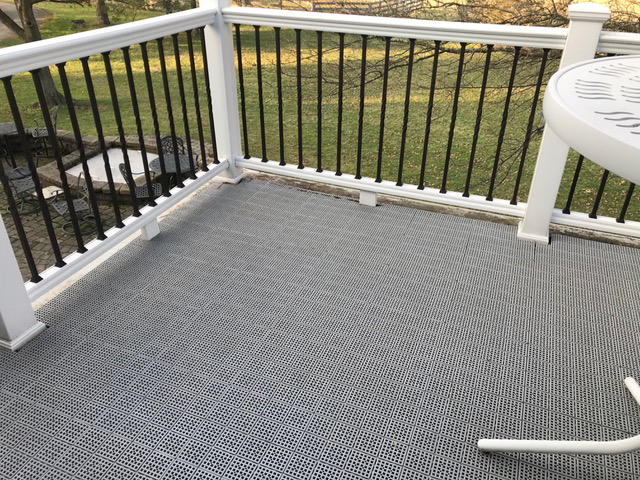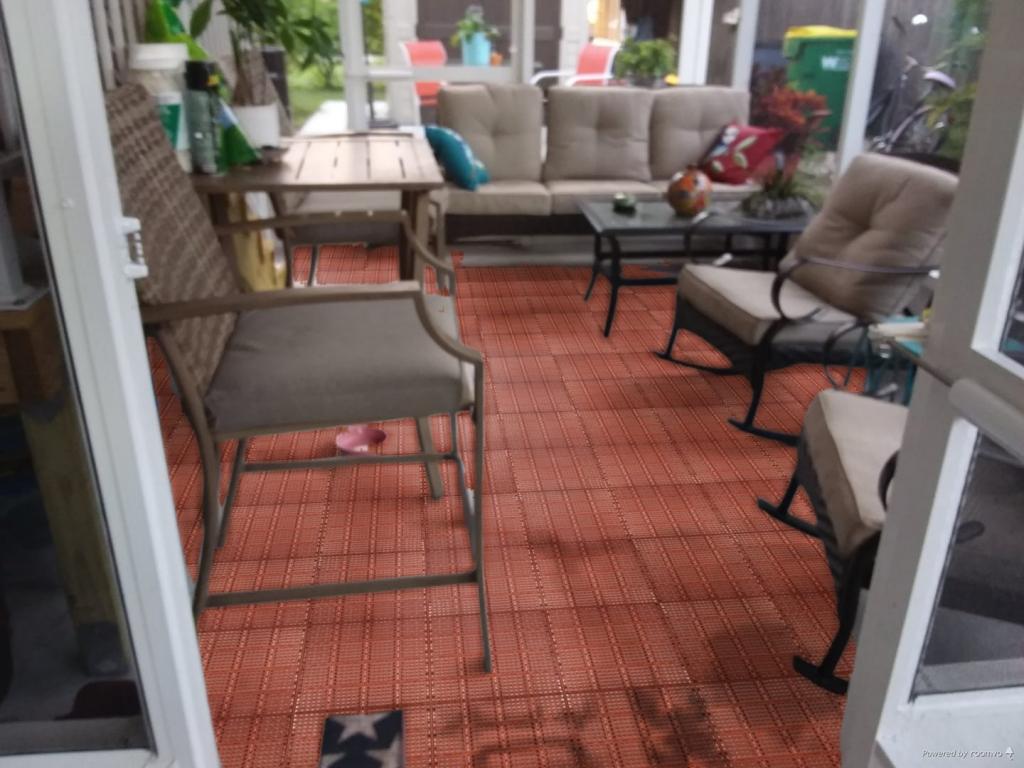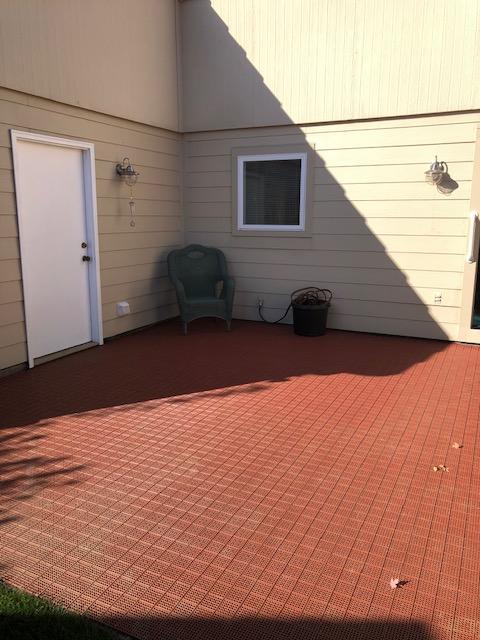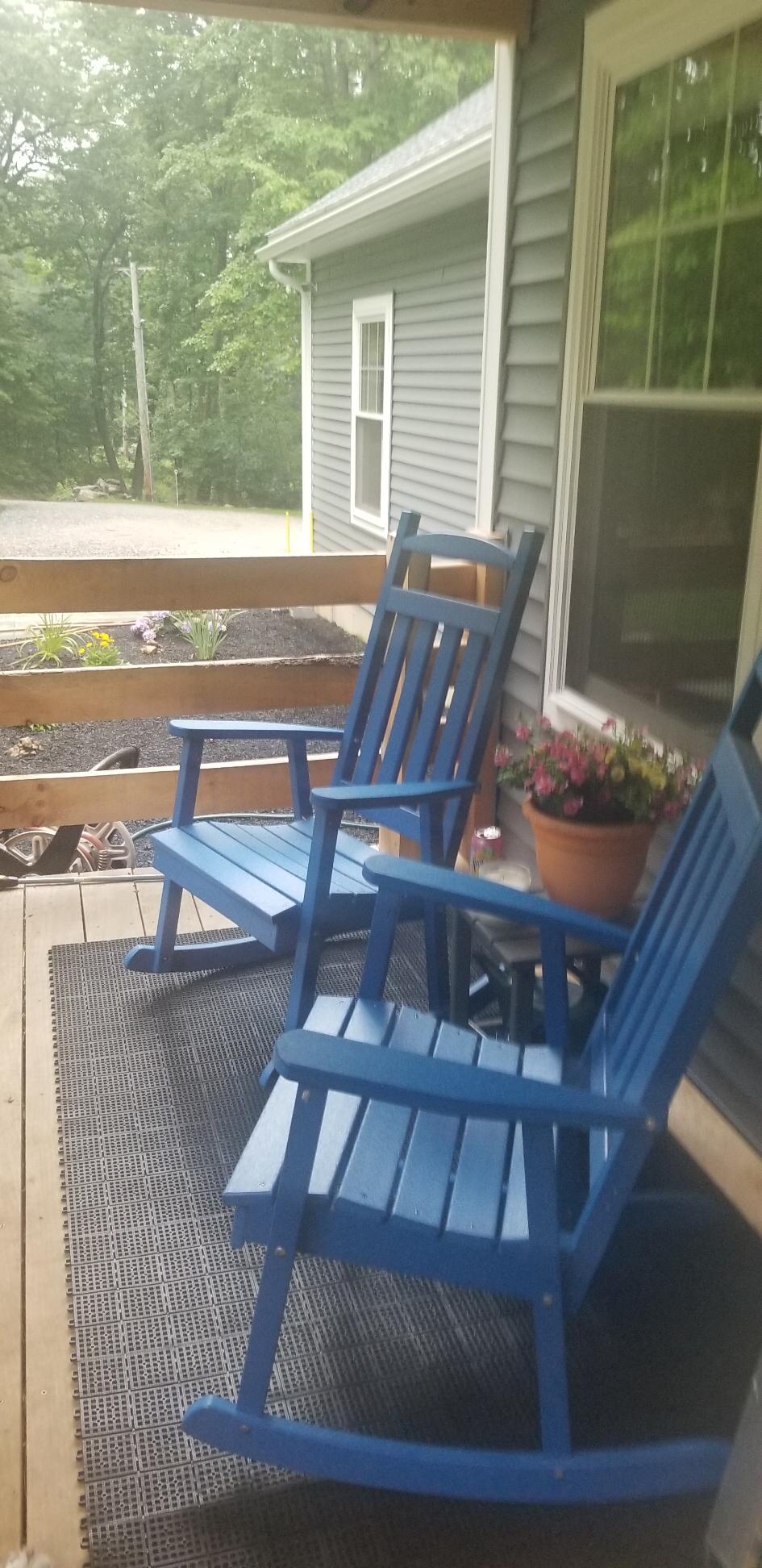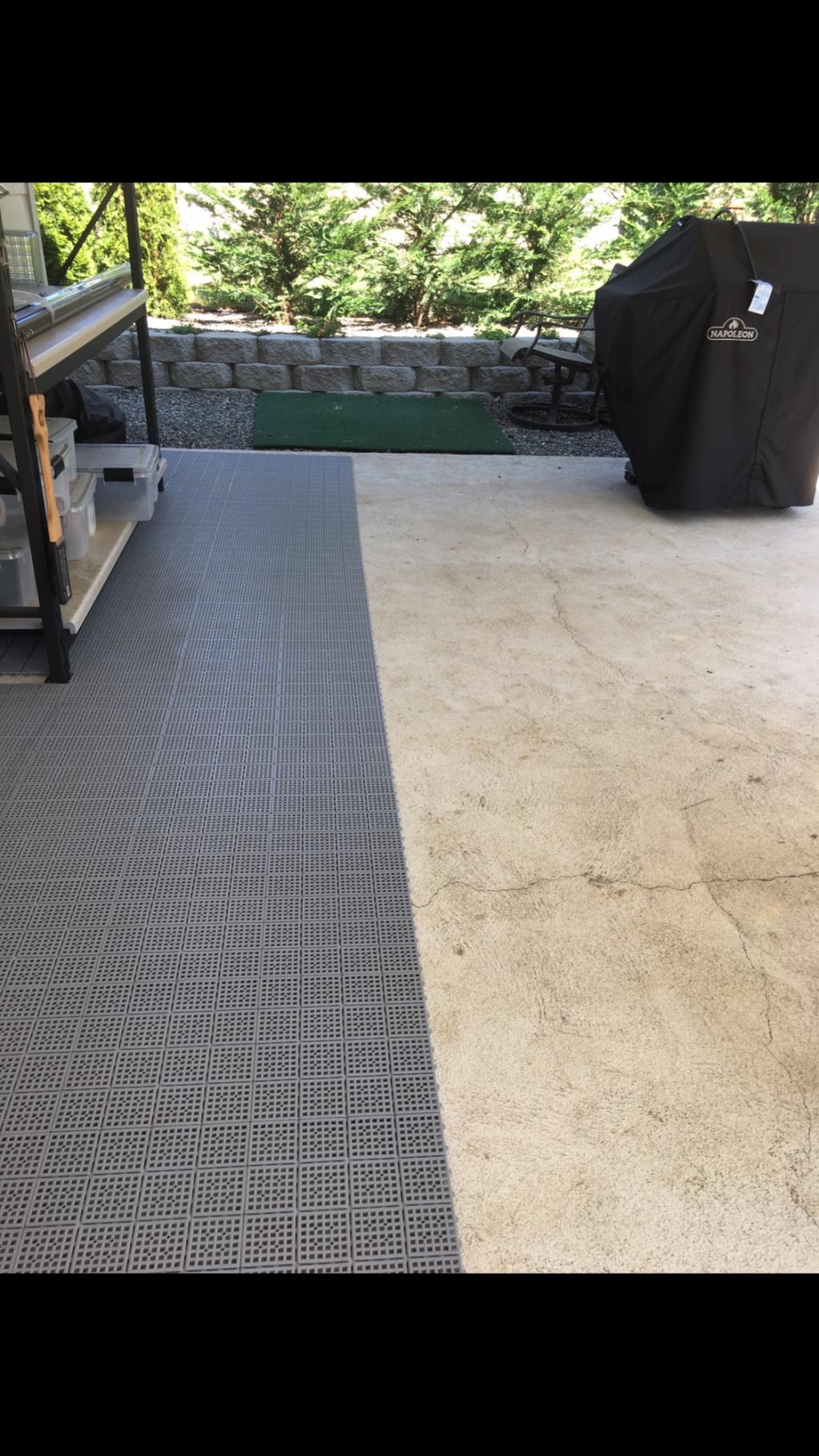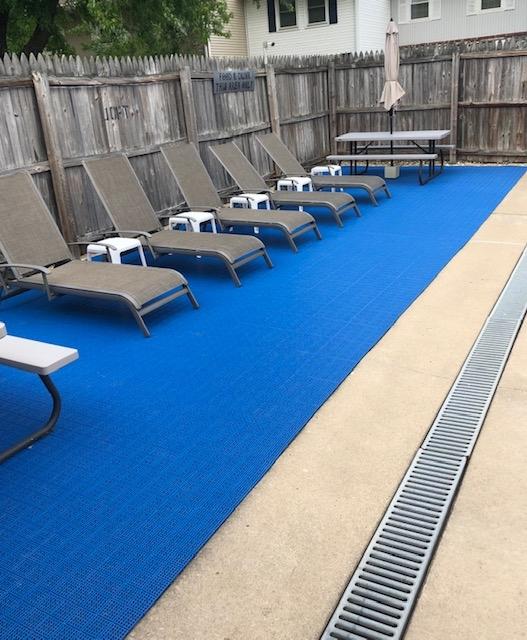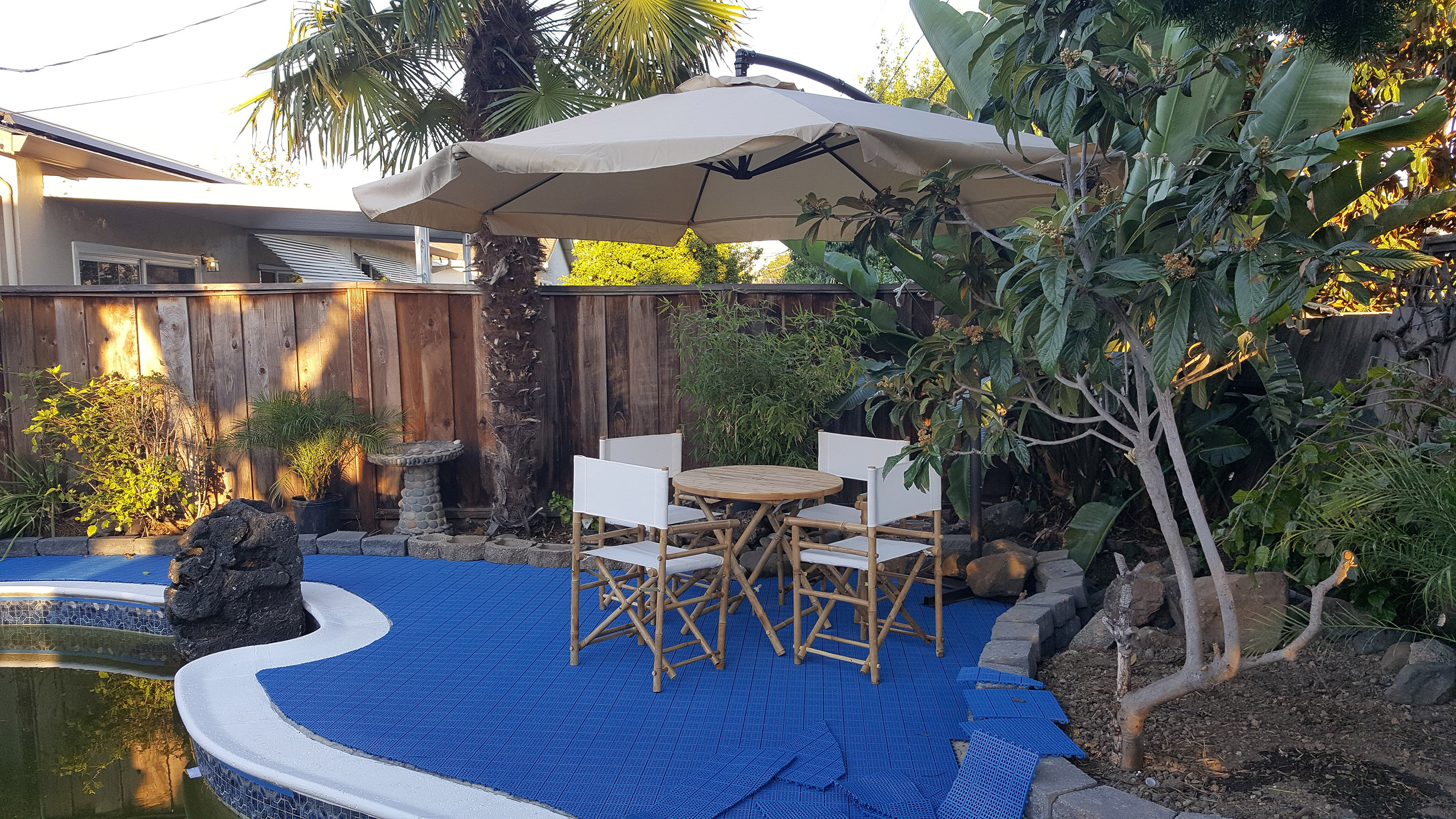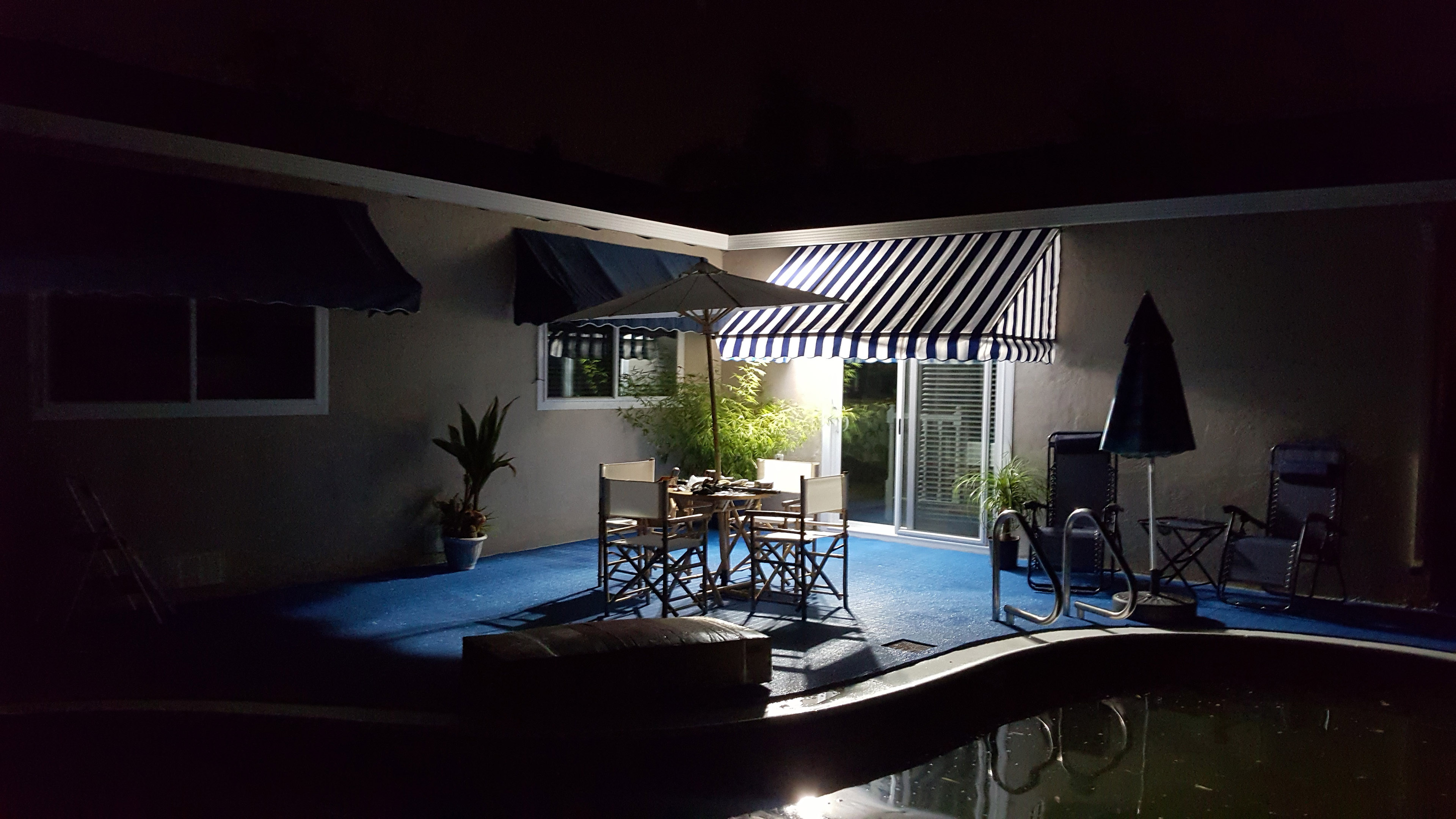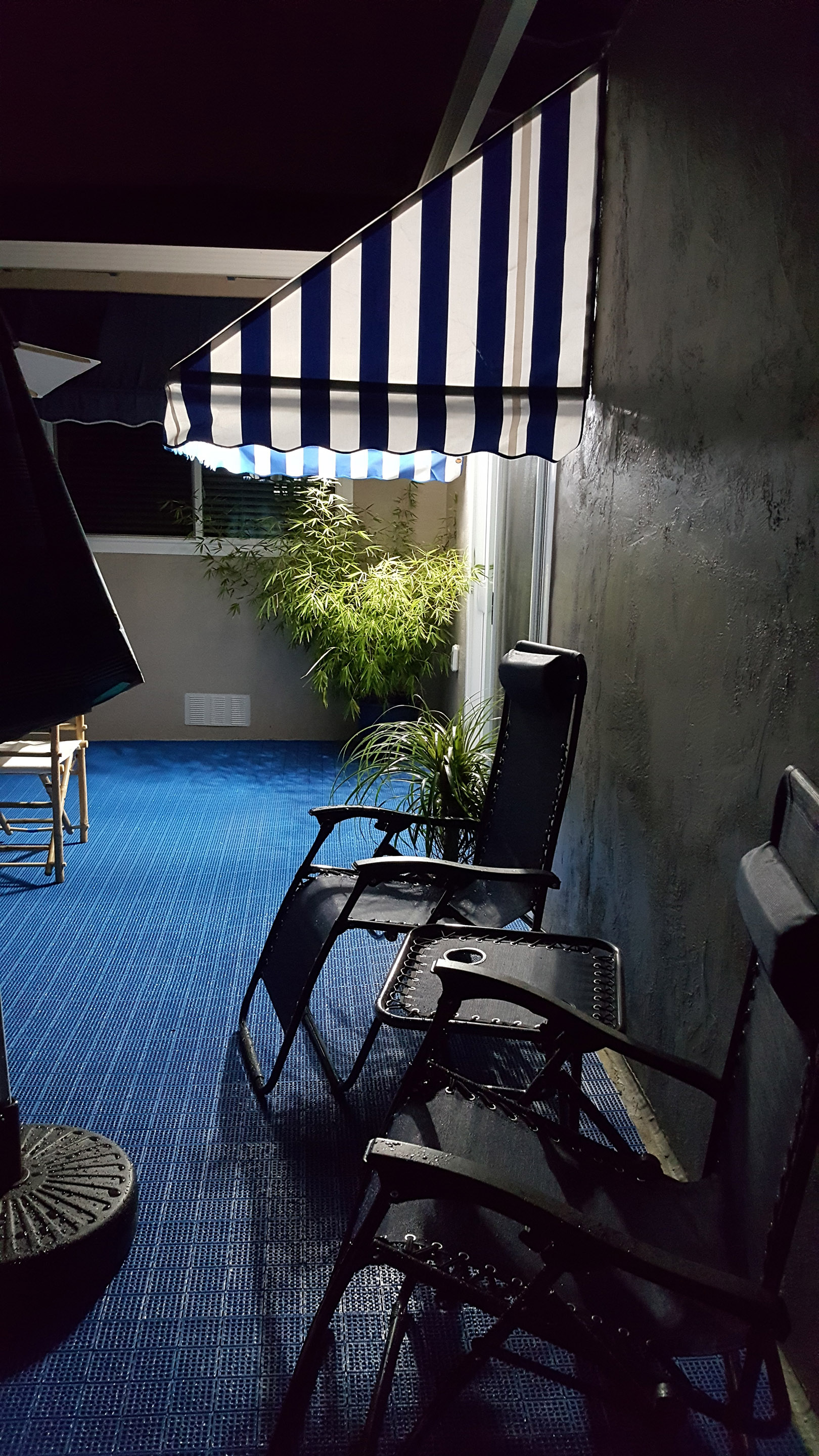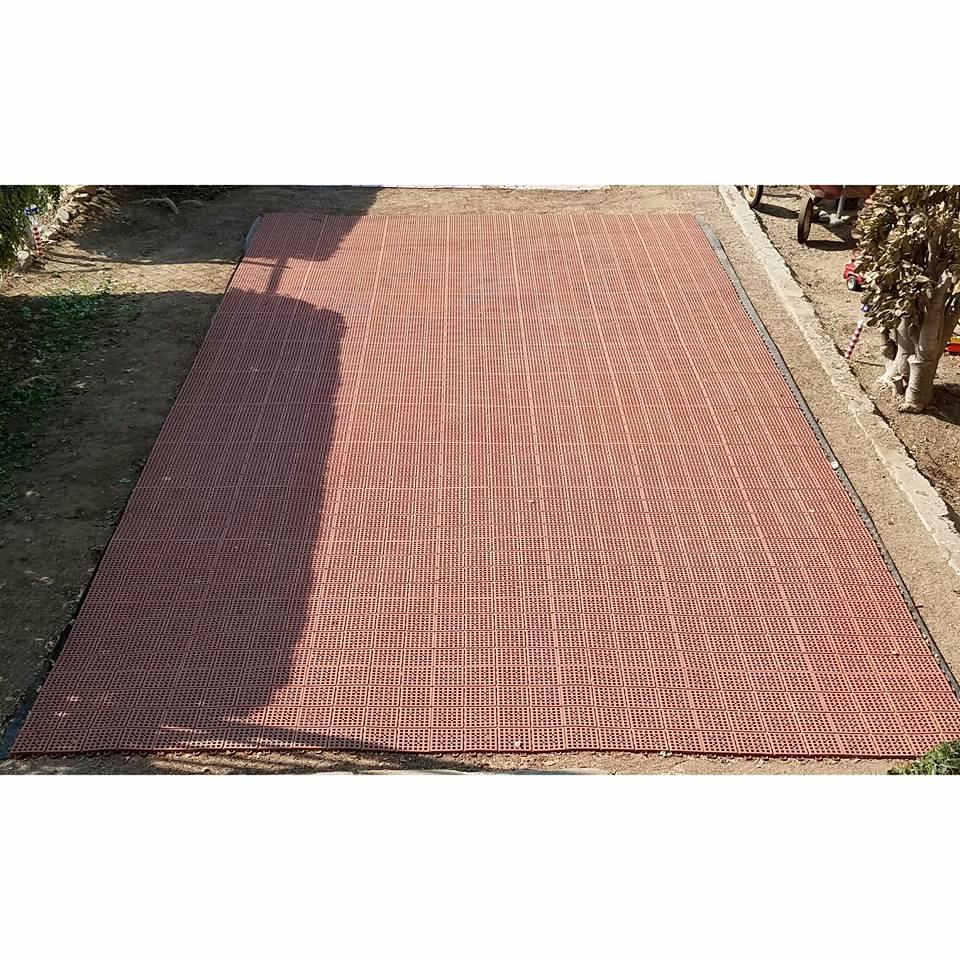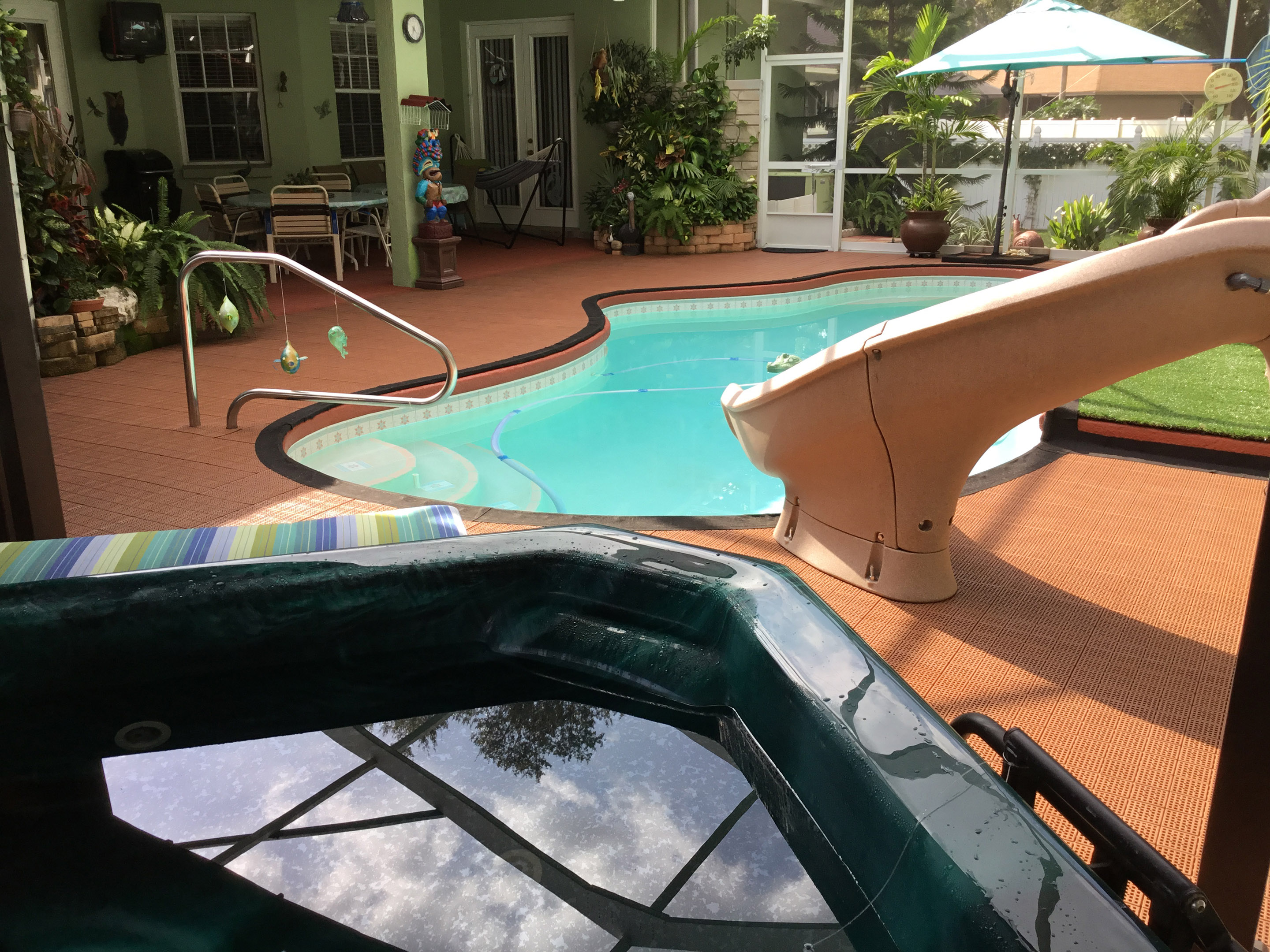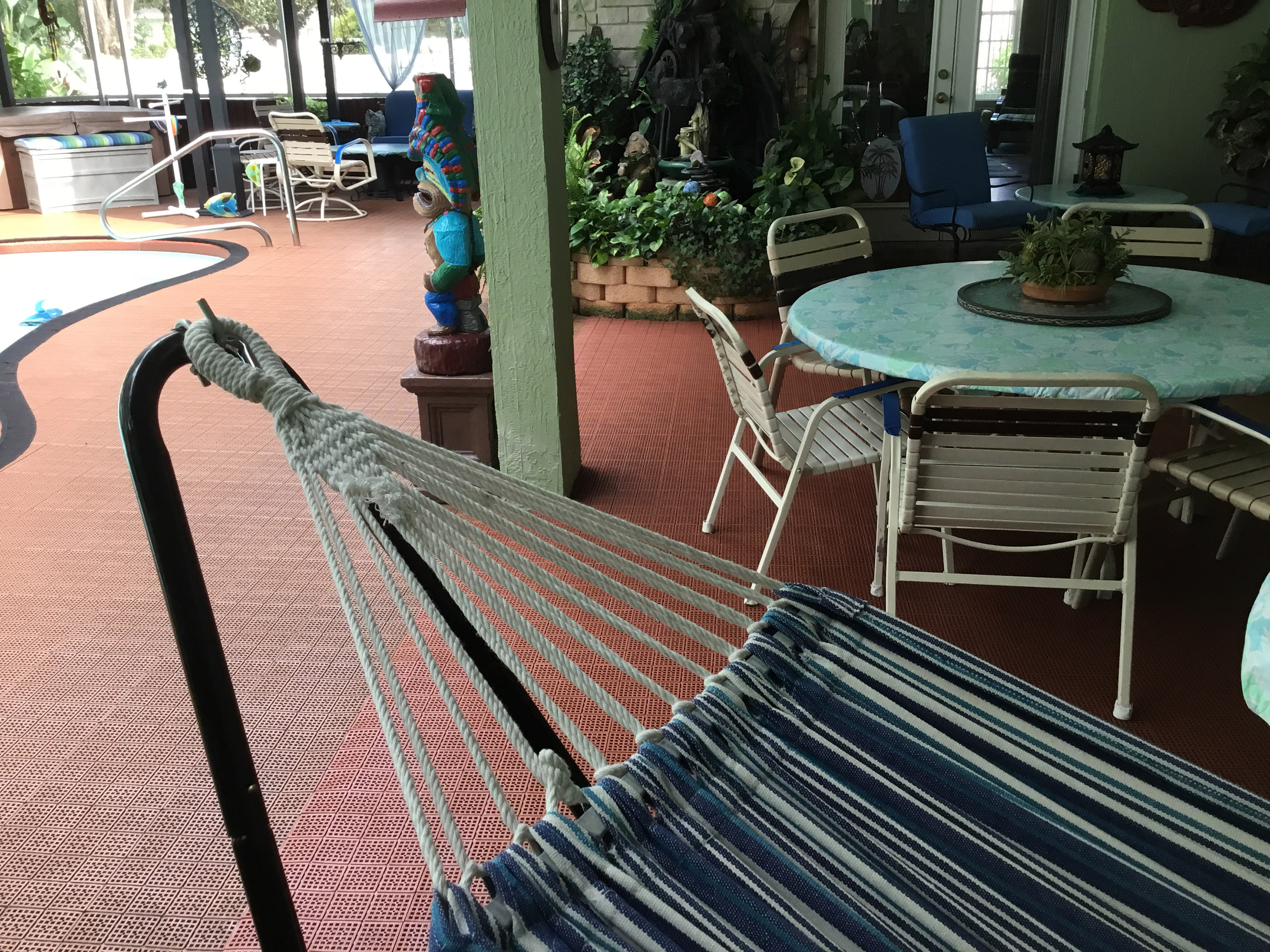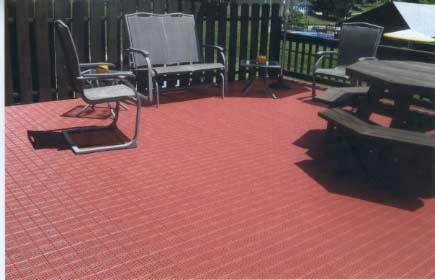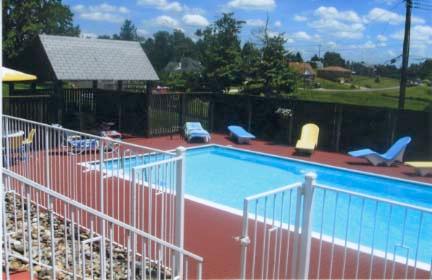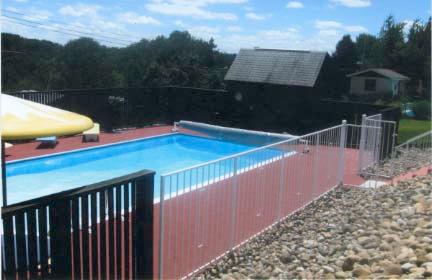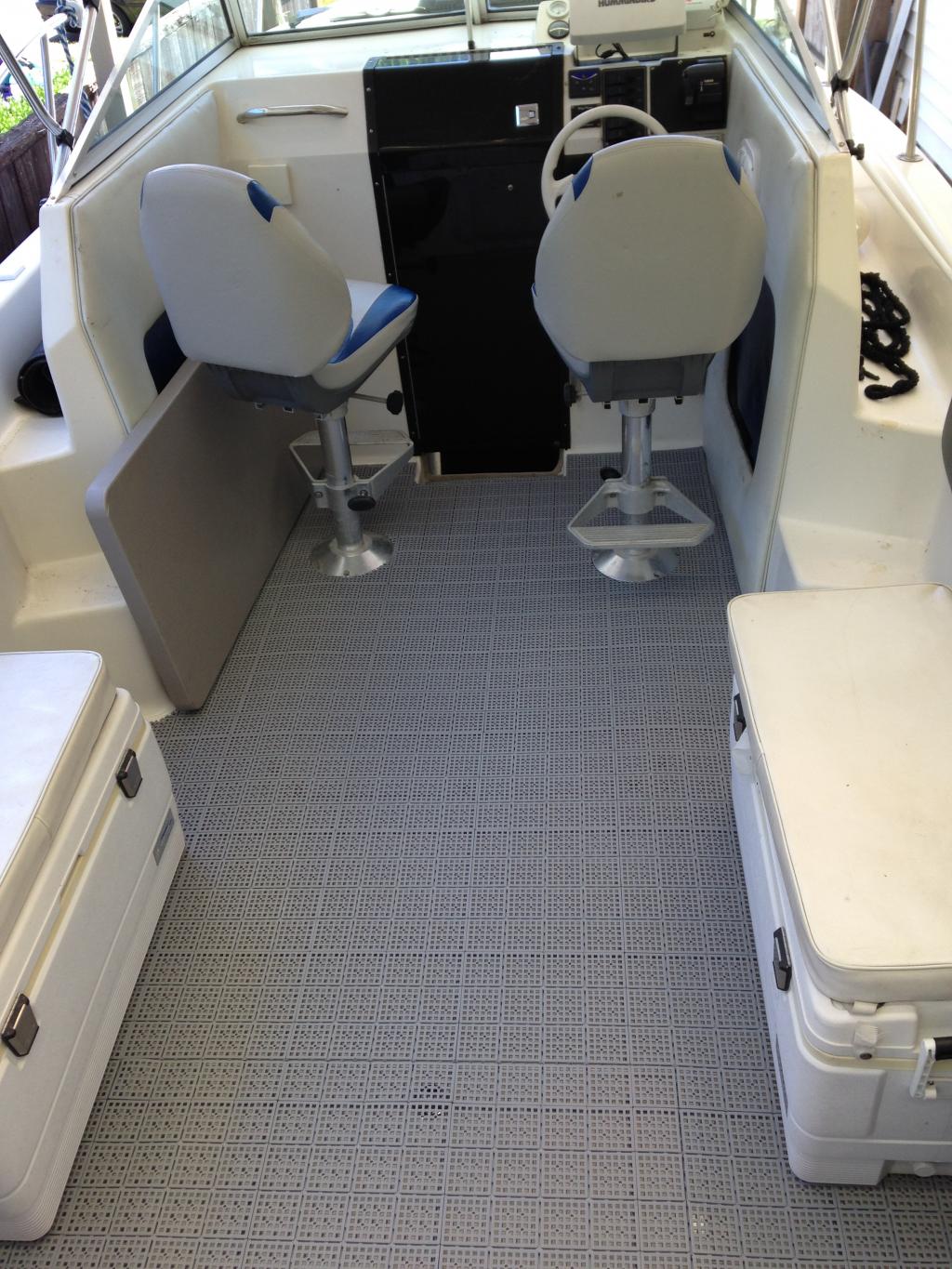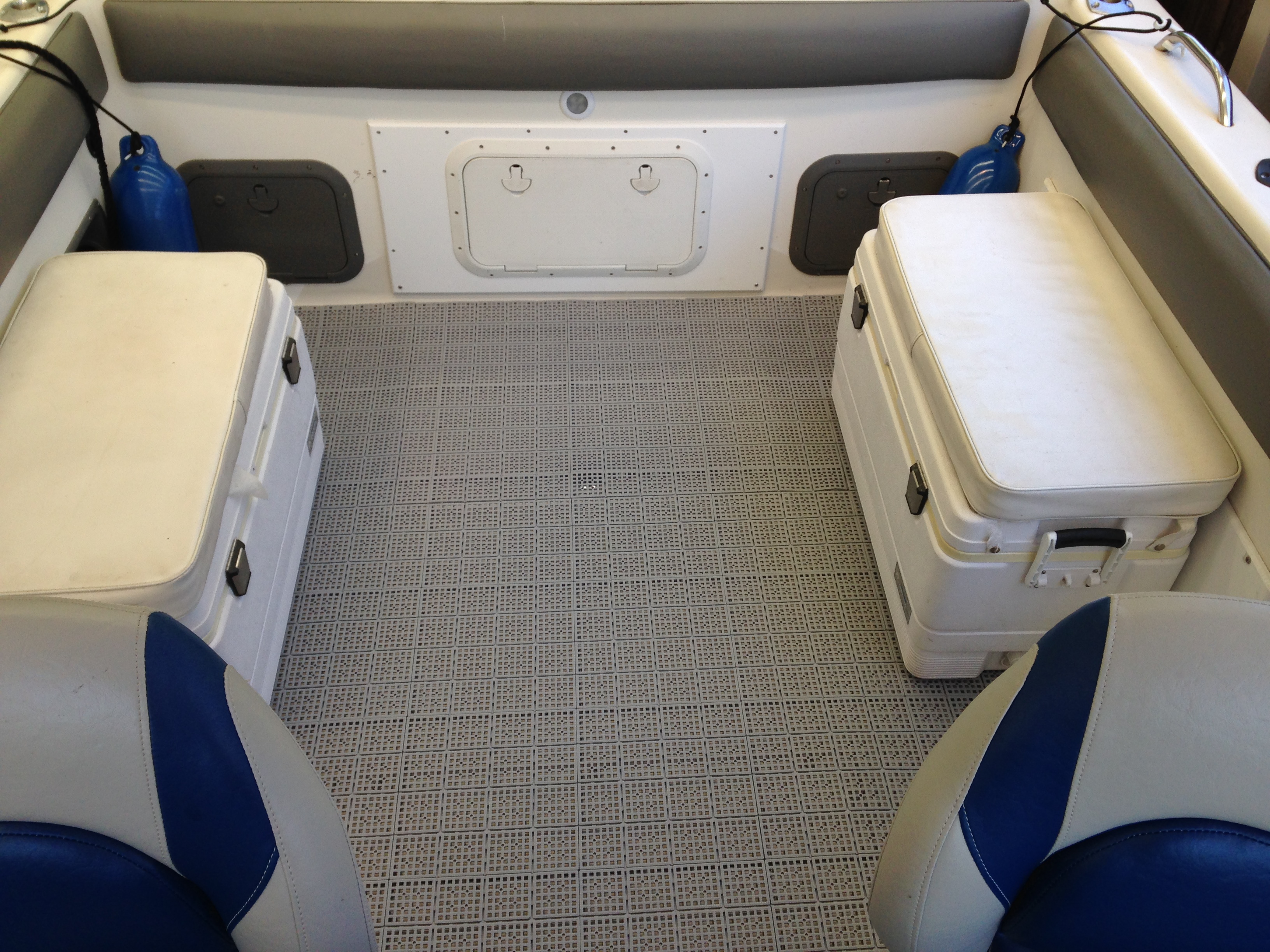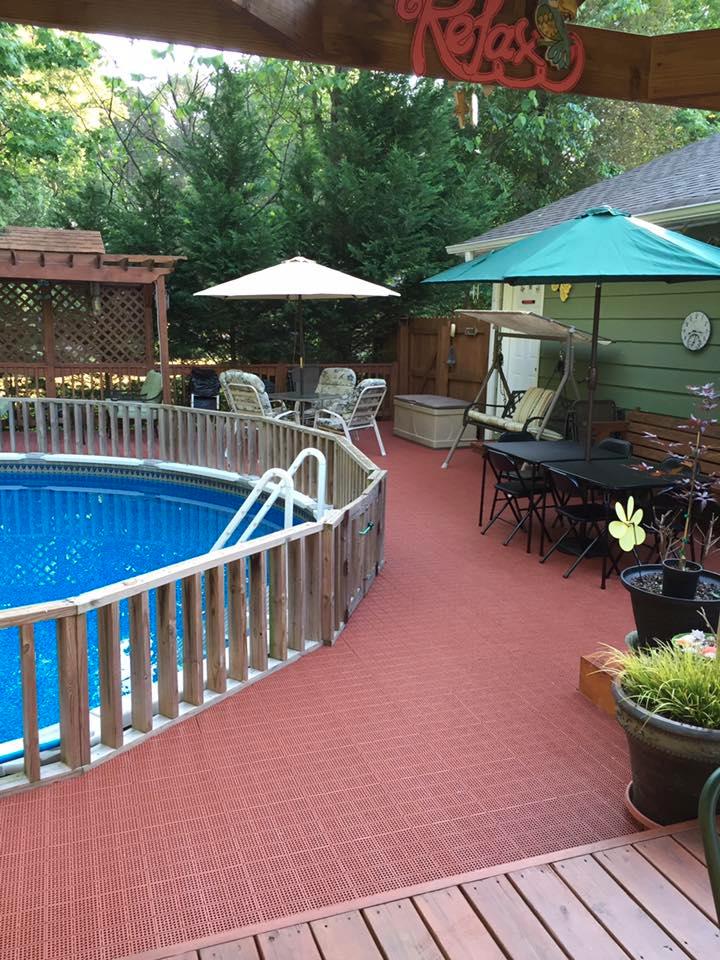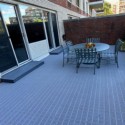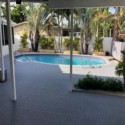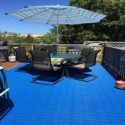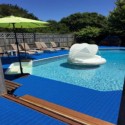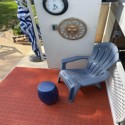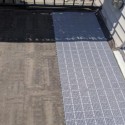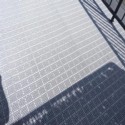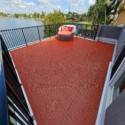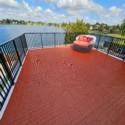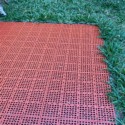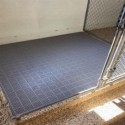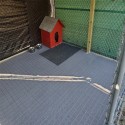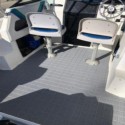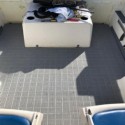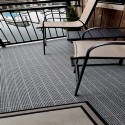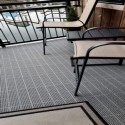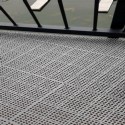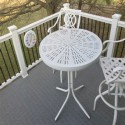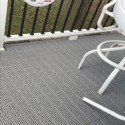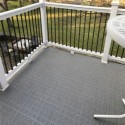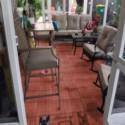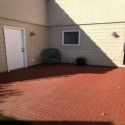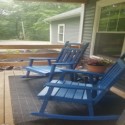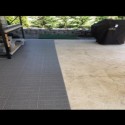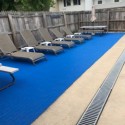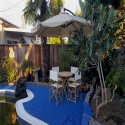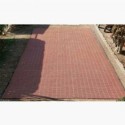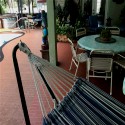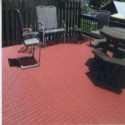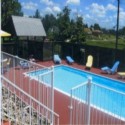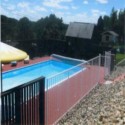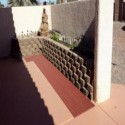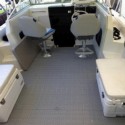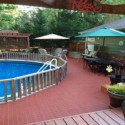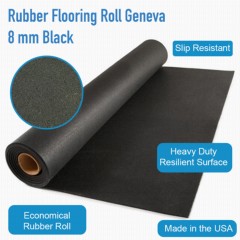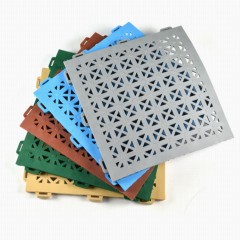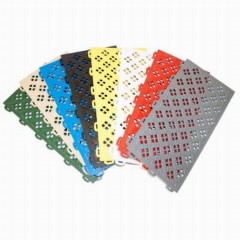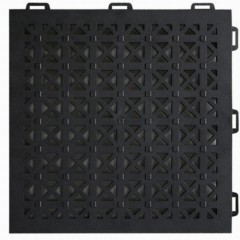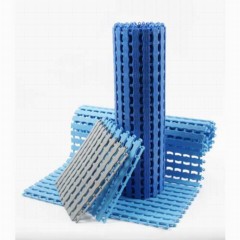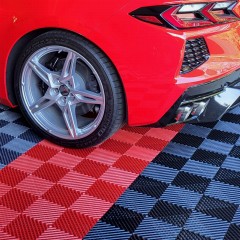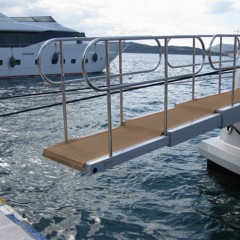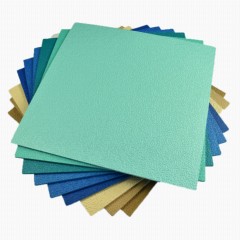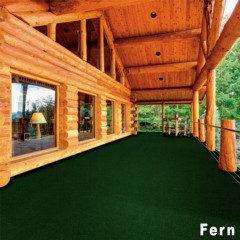Patio Outdoor Tile 1/2 Inch x 1x1 Ft.
- Safe surface with a slip-resistant texture
- Waterproof flooring for use in wet areas
- Flexible material that has a bit of cushioning
- See More Details
- Safe surface with a slip-resistant texture
- Waterproof flooring for use in wet areas
- Flexible material that has a bit of cushioning
- Easy installation with connectors on the edge
- Conveniently sized tile at about 1x1 feet for installation
- Allows water to drain through the perforations
- Fits directly over the top of compacted surfaces or concrete
- Perfect for indoor or outdoor use
Wet areas near pools, Locker rooms, Greenhouses, Boat decks, Outdoor game courts, Outdoor decks and patios, Rooftop decks
Perfect Wet Area Flooring Installation
Wet areas require a tough type of flooring that will resist the formation of mold and mildew. Our PVC plastic outdoor patio tiles are waterproof.
These slip-resistant tiles are the best flooring for placing around pools. When the pool area needs tiles that go over concrete, the nonslip material protects kids who may be running from falling and injuring themselves.
High-traffic wet areas can also benefit from Greatmats PVC outdoor tiles. If you have a locker room space at a commercial gym or if you need durable flooring in a utility room at home, these tiles are a popular choice.
Some customers choose to use these tiles to create a greenhouse floor, a boat deck, or an outdoor basketball or tennis court.
High-Quality Outdoor Patio Tiles
For a refreshed look for a worn deck or patio area, our non-slip outdoor tile can go over wood directly. This deck floor cover provides the best answer to ''What can I cover my old deck with?''
Our PVC interlock tiles are among the best wood deck covering ideas that we offer. They can also hide worn, cracked concrete.
Our outdoor tiles contain perforations to allow water to drain through to the deck material below, eliminating puddles.
DIY Installation Outdoor Patio Tiles
Our perforated PVC tiles carry a good value for customers, providing a reasonable cost per square foot for an outdoor deck covering.
Additionally, because you can install these outdoor patio tiles yourself, you save money versus having a pro refurbish an existing wood deck or a rooftop patio.
Our tiles have an interlocking system on all four sides, making it easy to attach each tile to the adjacent tile. Installation does not require glue, which further simplifies the process.
Attractive Color Options for Rooftop Decks
Give your deck or patio a fresh, contemporary look with our tiles. Select among four different color options, so you can create the most beautiful layout that complements the design elements you already have in the area.
Because each tile uses the same interlocking system, you can mix and match colors, if desired.
The four primary colors available include:
- Blue
- Gray
- Tan
- Terra Cotta
Disclaimer
Color variation is possible from lot to lot, even within the same order.
Maintenance
Product can be damp mopped with common household floor cleaners; avoid bleach.
Shipping
Ships in cartons via ground service to your door; for larger orders, products may ship via freight delivery.
Please review our shipping disclaimer.
WARNING: This product can expose you to chemicals including Lead and/or Phthalates, which are known to the State of California to cause cancer and birth defects or other reproductive harm. For more information go to www.P65Warnings.ca.gov.
| SKU# | PTA.5 |
| In Stock | Yes |
| Product Type | Tile |
| Material Type | PVC Plastic |
| Product Edging | Straight |
| Thickness | 1/2 inch |
| Width | 0.96 feet |
| Length | 0.96 feet |
| SF per Item | 0.92 |
| Weight | 1.00 lbs |
| Packaging | Cartons |
| Non Absorbent | Yes |
| Special Adhesives | No |
| Universal Interlock | No |
| Interlock Loss | 0.00 feet |
| Material Hardness | Shore A 89 |
| Interlocking Connections | Yes |
| Made In | Taiwan |
| Surface Finish | Perforated top |
| Surface Design | Solid color |
| Installation Method | Interlocking, dry lay |
| UV Treated | Yes |
| Reversible | No |
| Border Strips Included | No |
| Indoor or Outdoor | Outdoor |
| Manufacturer Warranty | 1 year limited |
Product Questions:
Q: Can I use this under a children's play area with a swing set?
Q: How do you cut this material for rounded edges, etc? Is a regular scissors sufficient?
Q: What is the grid opening size?
Q: Is the underside of the Patio Outdoor tile damaging for a rubber membrane roof? Especially with a container garden box on them?
Q: I have a basement that takes on water with an uneven floor. I would like to lay down some inexpensive tiles like these and possibly top it with some fake turf for working out. Will this product form on the uneven floors, and handle jumping and basic work out equipment?
Q: Does this product have a fall height rating? Can it be used for a safe play area for children?
Q: Does this product have to go over a hard surface, like concrete, or can it go over dirt?
Q: I live in a snowy area. Can these tiles be shoveled over without moving or damaging them?
Q: How easy is it to slide patio furniture? An example would be sliding your chair out from under the table while sitting.
Q: How do these mats perform with dirt build up in the holes and how do you clean out the holes full of dirt, And with water trying to drain, would it not plug up the drainage?
Q: Which tile would be best to put underneath an outdoor sauna? I do not want water to sit underneath the sauna but I want a barrier for water to flow underneath.
Q: Can this tile go over a balcony deck with a PTO membrane?
Q: How would this product work for a basketball court? We are thinking about installing it over dirt.
Q: My cement patio has a deep, uneven crack going all the way through the middle (tree roots cracking the cement). Would these patio tiles work to make the patio seem more even and smooth? Or would the uneven crack make the tiles uneven?
Q: Is there edging available for this tile? If not, how do you finish off the edge especially if you have to cut the tile?
Q: How much weight can I put on these tiles?
Q: Can this product be installed directly over a rolled roof?
Q: I have a wood deck in really bad shape. Some boards are cupped. Will the tiles show these cups once installed? Also, would you use this or the 3/4” product?
Q: Is this tile more flexible, or more rigid?
Q: Would these mat tiles get too hot to walk on barefooted by the pool in direct Arizona sun?
Q: I want to cover my brick patio with the Patio Tile. It is very uneven. If I level it off with sand is that a good option?
Q: I love these tiles but I got some water-based paint overspray on them, what would you suggest using as the best way to take the paint off?
Q: Could I put a 10' x 30'' children's pool on top of these tiles?
Q: Can these be used for an outdoor dog kennel? Can these be cut to fit?
Q: Are these tiles for a sheep barn or pasture?
Q: Can these be laid over rock gravel?
Q: I'd like to make a garden walkway over grass, the ground is somewhat level. Is this tile a good choice or would you recommend something else? I had considered cement pavers but too heavy for me to get and move.
Q: What is your return policy?
Q: We live in a very cold area (-28 degrees at times) with a lot of snow. Will these hold up to those conditions? Also, we would like to put over an old wooden deck, will these let moisture stay under them to eventually rot the wood?
Q: Can these be used on top of an above-ground aluminum pool deck? There is carpeting on the deck now. Can these be put down directly onto the aluminum and/or the outdoor carpeting?
Q: Is this outdoor tile suitable for putting on top of old carpet in a pontoon boat?
Q: Can I use this for the rooftop? Will this protect the roof from getting leaks?
Q: Is this product ok for outdoor pickleball courts?
Q: Are these tiles rated to be left outside all year in a region with all four seasons, i.e., snow to 100-degree summer days?
Q: I’m looking for something to put under my pontoon boat seats (on top of the vinyl flooring), to provide protection for the flooring (e.g from the anchor) and to slightly raise items off the floor so water can run underneath. I wouldn’t want to damage the vinyl flooring. Is this a good option?
Q: What is the best tool for cutting the interlocking outdoor tiles? I just received them and will be installing them over the worn wood deck (painted) this weekend.
Q: What’s the difference between this and the staylock deck tiles?
Customer Rating:
10/17/2024
attached are two photos of my new terrace floor. With the help of my three grandsons it was finished in one afternoon. Thanks for your help!
Charles
Customer Rating:
08/17/2022
I love the product so far. I laid all 600 plus tiles by myself in 3 days, part time, and the installation was easy. I would recommend a rubber Mallet for assistance. We liked the product so much we are now planning where else we can use it.
Troy
Yarmouth, NS
Customer Rating:
08/08/2021
Great product, i was tired of scraping and staining every other year. There are a lot of different deck tile products out there. Simply put if you are going to cover your wooden deck you need ventilation and drainage or you'll be dealing with rot and mildew and these outdoor tiles are by far the ones. Simple to install. Highly recommended.
Thank you,
Doug V.
DOUGLAS
Barkhamsted, CT
Customer Rating:
06/24/2021
We purchased your patio outdoor gray tile to cover our outdoor area around our pool. The concrete was slippery and sloppy. We skim coated a few really bad areas. These photos show how wonderful this came out. We are putting a screen enclosure over this area and haven’t finished it yet.
We will be ordering a different colored product for our front porch next year.
Burton
Ballston Spa, NY
Customer Rating:
08/10/2020
We are very happy with our deck now that it is covered by Greatmats tiles. We can walk bare footed during the hottest part of the day. This was not possible when it was a steel deck. It also receives many compliments on how it looks.
Richard
Lake Oswego, OR
